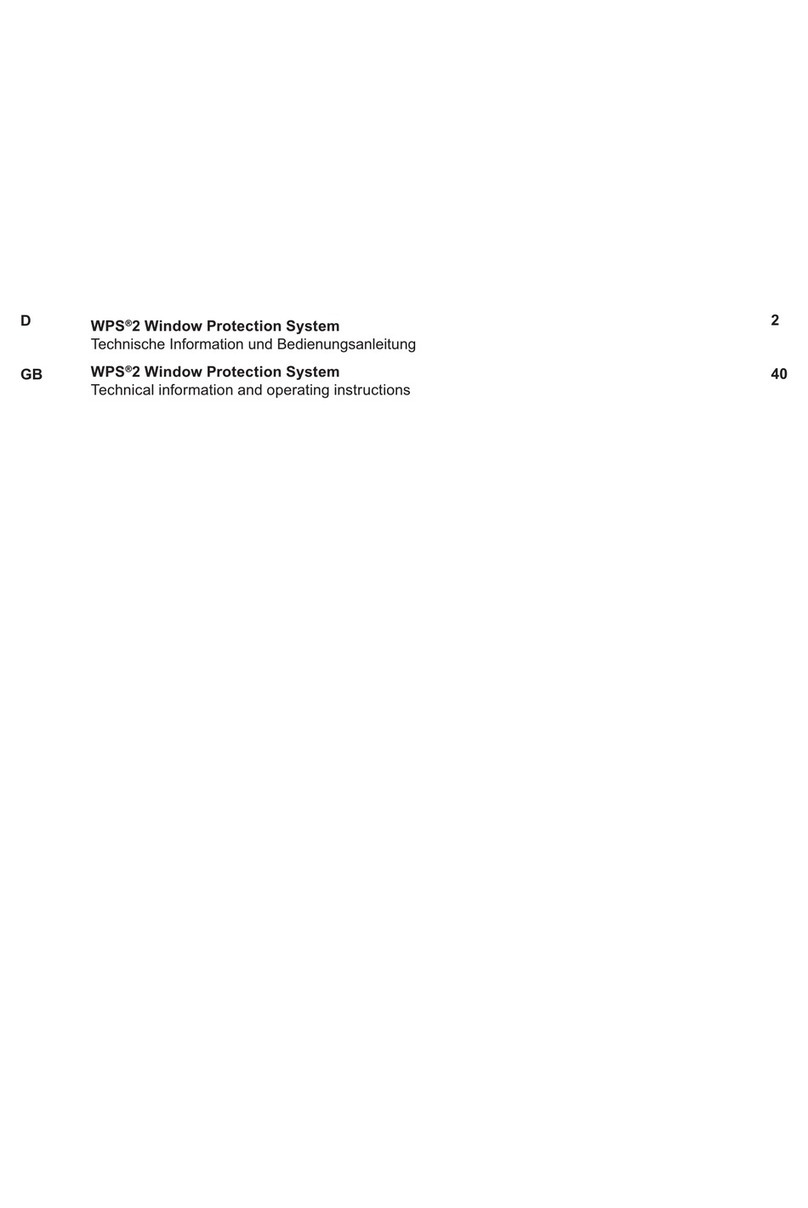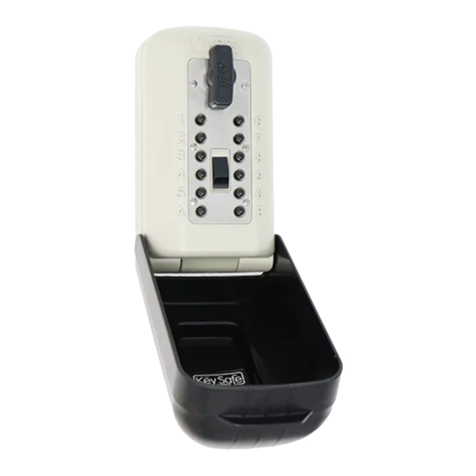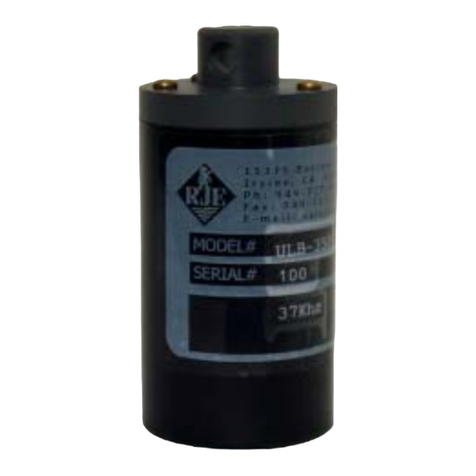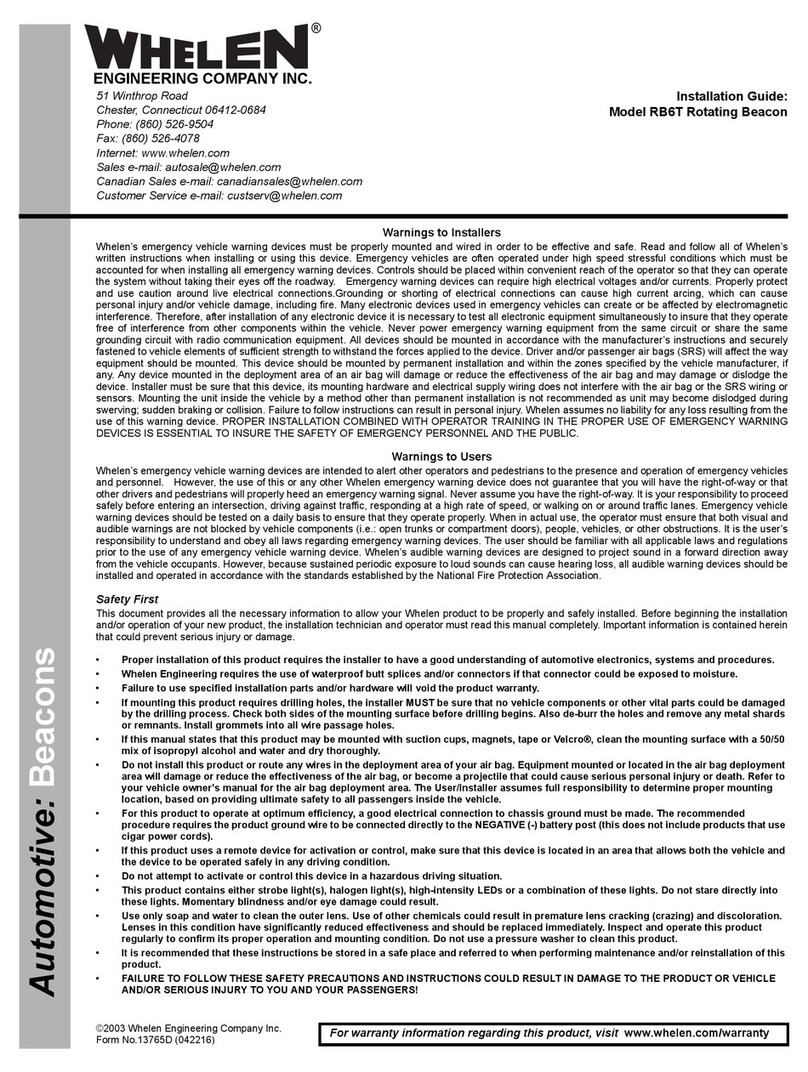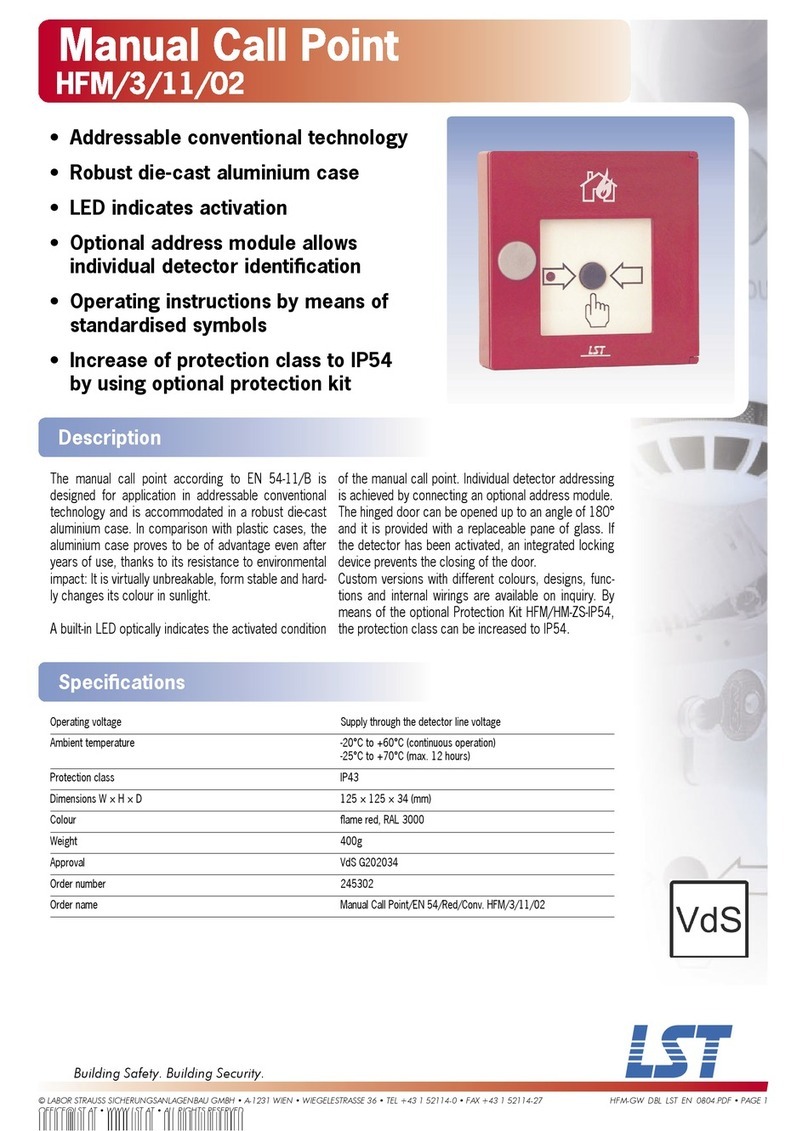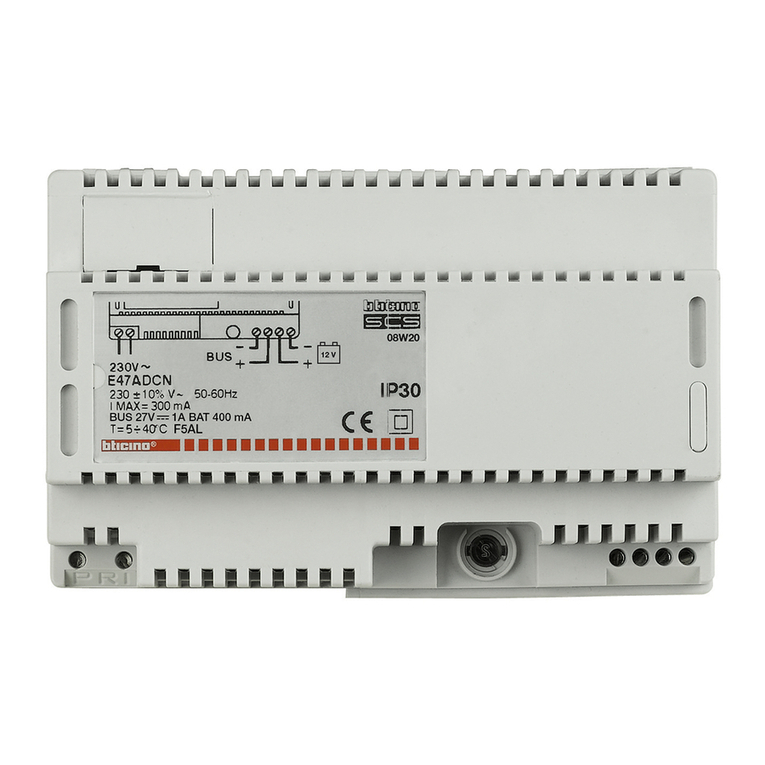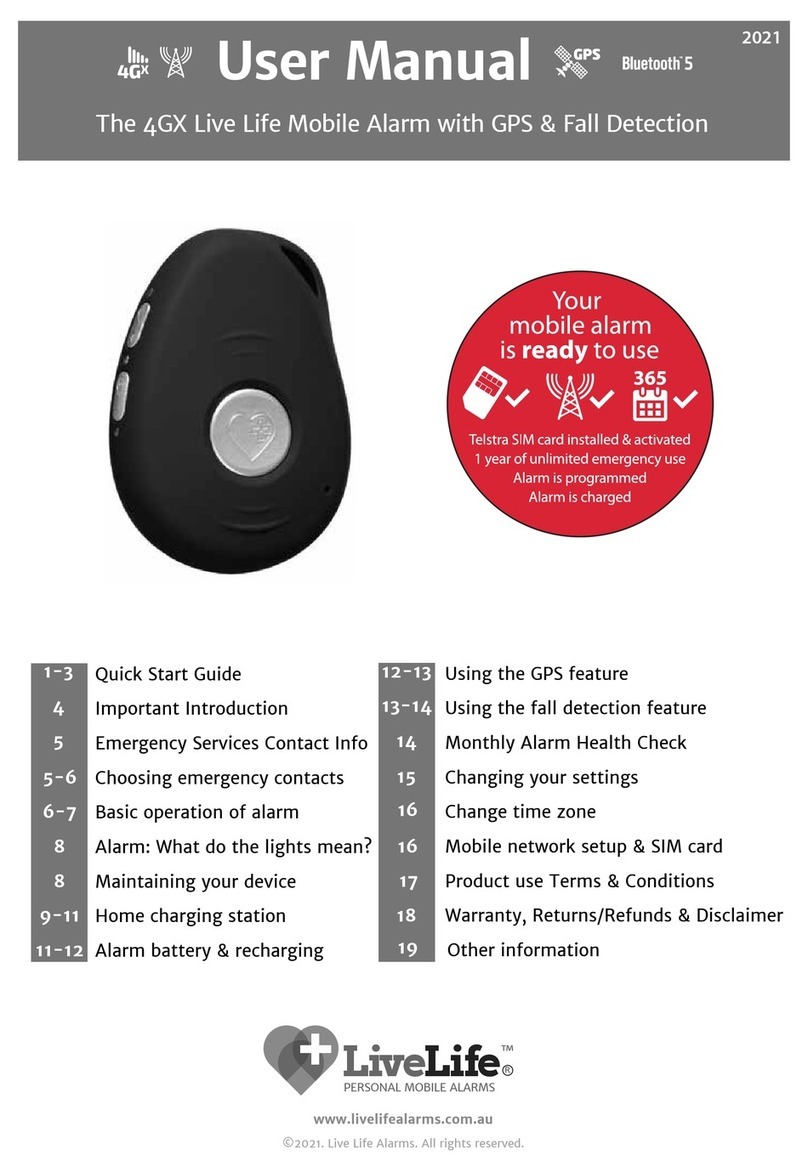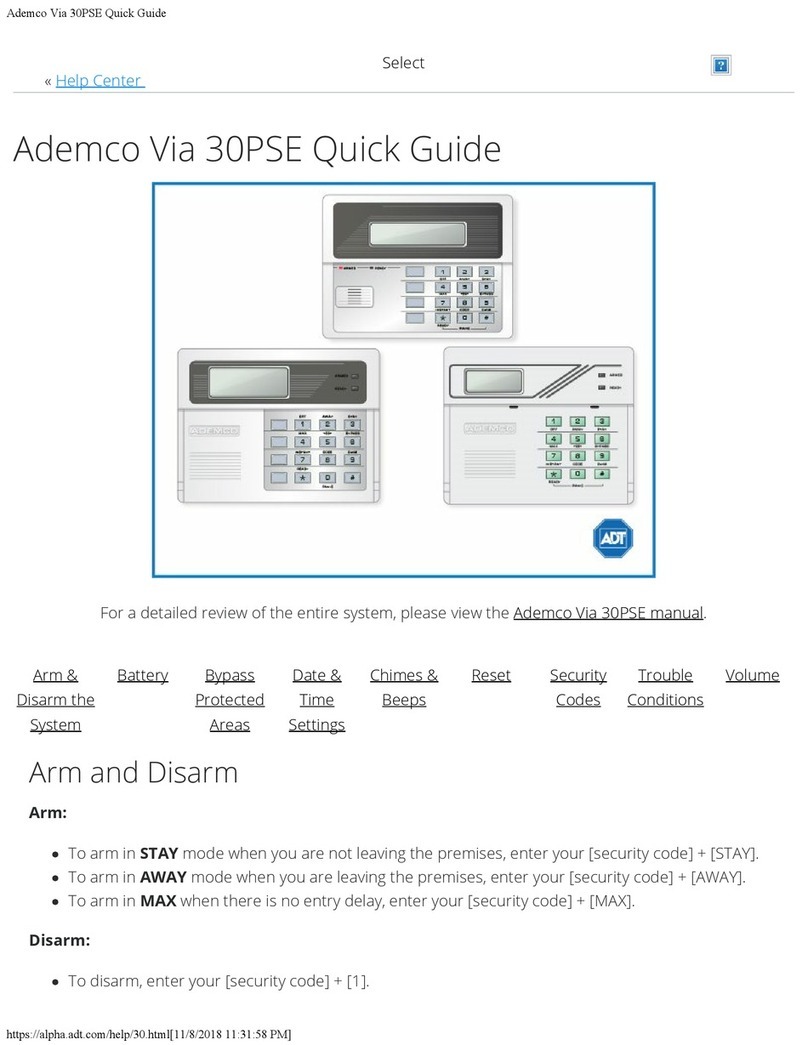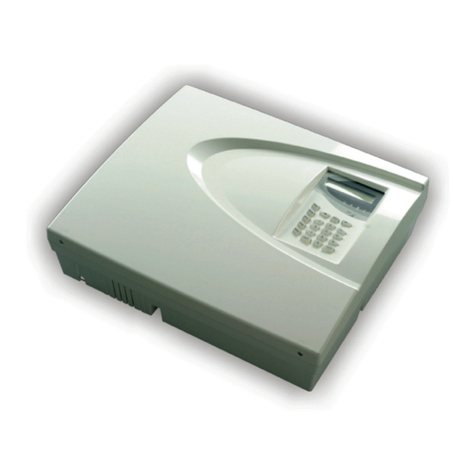STG-BEIKIRCH GAM 1 Manual

Diese Bedienungsanleitung für späteren Gebrauch bzw. Wartung aufbewahren. Please keep these operating instruction for future reference and maintance.
Änderungen dienen dem technischen Fortschritt und bleiben vorbehalten. Abbildungen unverbindlich. Subject to technical modifications. Diagram is not binding.
Technical information
and operating instruction
Technische Information
und Bedienungsanleitung
Version: 1 valid from: 25.08.2009
GSM Alarm Module GAM 1 and GAM 2
Diagnosis module for remote transmission of alarm and malfunction signals
Function
The GAM is a GSM alarm module which
is easy to install and to use. It is suitable
for remote control in industrial and private
facilities managment, in particular for MZ,
MZ2 and LON SHE control panels.
Special features
• monitoring of two digital inputs can be
configured and activated over
conventional mobile telephones
• a relay switch can also be
installed
• up to 5 additional telephone numbers
can be stored. These numbers
receive an SMS message from the
GAM if a fault occurs or if the inputs are
activated
• the device can be configured and
commissioned simply and without any
software tools or programming
knowledge
• GAM 2 with an identical range of
functions, but with integrated battery for
transmitting signals in the event of a
mains power failure
Note: Only an activated SIM
card from any network provider is needed
for commissioning purposes. SIM card,
configuration and commissioning are
not included in the GAM module delivery
package.
GSM Alarm Modul GAM 1 und GAM 2
GSM Alarm Module GAM 1 and GAM 2
Stabantenne mit Magnetfuß für Alarm Modul GAM
Rod antenna with magnetic base for GAM alarm module
Klebeantenne für Alarm Modul GAM
Adhesive patch antenna for GAM alarm module
Ausgabe: 1 Gültig ab: 25.08.2009
Datei:
Ti_GAM1_GAM2_dt_engl.indd
Art.Nr. 24999541
GSM Alarm Modul GAM 1 und GAM 2
Diagnosemodul zur Fernübertragung von Alarm- und Störungsmeldungen
Funktion
Das GAM ist ein einfach zu installierendes
und zu bedienendes GSM Alarm Modul.
Es eignet sich zur Fernkontrolle im
industriellen und privaten Gebäude-
management, vorzugsweise für MZ, MZ2
und LON RWA Zentralen.
Besonderheiten
• über herkömmliche Mobiltelefone
können die Zustände zweier digitaler
Eingänge überwacht werden
• zusätzlich besteht die Möglichkeit ein
Relais zu schalten
• bis zu 5 weitere Telefon-Nummern
können gespeichert werden, welche im
Falle einer Störung bzw. einer
Aktivierung der Eingänge eine SMS-
Nachricht durch das GAM erhalten
• das GAM kann einfach und ohne
jegliche Software-Tools oder
Programmierkenntnisse konfiguriert und
in Betrieb genommen werden
• GAM 2 mit identischem Funktions-
umfang, jedoch mit integriertem Akku
zur Weiterleitung von Meldungen bei
Netzausfall
Hinweis: Zur Inbetriebnahme
wird nur eine freigeschaltete SIM Karte
eines beliebigen Netzbetreibers benötigt.
Eine SIM Karte, sowie die Konfiguration
und Interbriebnahme ist nicht im
Lieferumfang der GAM module enthalten.

2
Safety instructions
Please observe the following safety instructions which
are emphasized by special symbols.
Caution: Danger to persons due to electricity.
Warning: Non-observance leads to destruction.
Danger to material due to incorrect handling
Attention: Danger to persons due to risks arising from
the operation of the equipment. Danger of crushing/trap-
ping.
INFO
Warning 230 V AC: Dangerous voltage. Can cause death, serious injury or considera-
ble material damage. Disconnect the equipment from the power supply at all poles
before opening, assembling or carrying out any structural alterations. Observe VDE
0100 for 230 V power connection.
Please observe the following for assembly and operation: the window closes automa-
tically. When opening and closing, the drive unit is stopped by the power cut-off. The
corresponding pressure force is listed in the technical data. Take care - the pressure
force is high enough to crush your fingers. During assembly and operation, do not
interfere with the window gap or the travelling drive! Danger of crushing/trapping!
Operating instructions: for professional assembly, installation and appropriate mainte-
nance by trained, qualified and safety-conscious electricians and/or skilled staff with
knowledge of electrical equipment installation.
Read and observe the information contained in these operating instructions and re-
spect the order of procedure stated therein. Please keep these operating instructions
for future reference and maintenance. Reliable operation and the prevention of dama-
ge and risks are only granted if the equipment is assembled carefully and the settings
are carried out according to these instructions and to the operating instructions of the
drives. Please observe the exact terminal assignment, the minimum and maximum
power ratings (see technical data) and the installation instructions.
Application range: Exclusively for the automatic opening and closing of the stated
types of windows. For further application, please contact the manufacturer. It would
be beyond the scope of these safety instructions to list all the valide regulations and
guidelines. Always make sure that your system corresponds to the valid regulations.
Pay particular attention to: the aperture cross-section of the window, the opening
time and opening speed, the temperature resistance of the cables and equipment,
cross-sections of the cables in relation to the cable lengths and power consumption.
Required mounting material is to be adapted to the frame and the corresponding
load and is to be completed, if necessary. Any supplied mounting material is only part
of the required amount.
Maintenance works: If the equipment is employed in smoke heat extraction systems
(in short SHE), they must be checked, serviced and, if required, repaired at least once
per year. This is also recommended for pure ventilation systems.
Free the equipment from any contamination. Check the tightness of fixing and clam-
ping screws. Test the equipment by trial run.
The gear system is maintenance free. Defective equipment must only be repaired in
our factory. Only original spare parts are to be used. The readiness for operation has
to be checked regularly. For this purpose a service contract is recommended.
.
Sicherheitshinweise
Sicherheitshinweise, die Sie unbedingt beachten müssen,
werden durch besondere Zeichen hervorgehoben.
Vorsicht: Gefahr für Personen durch elektrischen Strom.
Achtung: Nichtbeachtung führt zur Zerstörung
Gefährdung für Material durch falsche Handhabung.
Warnung: Gefährdung für Personen durch Gefahren
aus dem Gerätebetrieb. Quetsch- und Klemmgefahr.
INFO
Warnung 230 V AC: Gefährliche Spannung. Kann Tod, schwere Körperverletzung
oder erheblichen Sachschaden verursachen. Trennen Sie das Gerät allpolig von der
Versorgungsspannung bevor Sie es öffnen, montieren oder den Aufbau verändern.
VDE 0100 für 230 V Netzanschluss beachten.
Beachten Sie bei der Montage und Bedienung: Das Fenster schließt automatisch.
Beim Schließen und Öffnen stoppt der Antrieb über die Lastabschaltung. Die entspre-
chende Druckkraft entnehmen Sie bitte den technischen Daten. Die Druckkraft reicht
aber auf jeden Fall aus bei Unachtsamkeit Finger zu zerquetschen. Bei der Montage
und Bedienung nicht in den Fensterfalz und in den laufenden Antrieb greifen!
Quetsch- und Klemmgefahr!
Bedienungsanleitung für die fachgerechte Montage, Installation und angemessene
Wartung durch den geschulten, sachkundigen und sicherheitsbewussten Elektro-
Installateur und / oder Fachpersonal mit Kenntnissen der elektrischen Geräteinstal-
lation. Lesen und Beachten Sie die Angaben in dieser Bedienungsanleitung und
halten Sie die vorgegebene Reihenfolge ein. Diese Bedienungsanleitung für späteren
Gebrauch / Wartung aufbewahren. Ein zuverlässiger Betrieb und ein Vermeiden von
Schäden und Gefahren ist nur bei sorgfältiger Montage und Einstellung nach dieser
Anleitung gegeben. Bitte beachten Sie genau die Anschlussbelegung, die minimalen
und maximalen Leistungsdaten (siehe technischen Daten) und die Installationshin-
weise.
Anwendungsbereich: ausschließlich für automatisches Öffnen und Schließen der
angegebenen Fensterformen. Weitere Anwendungen im Werk erfragen.
Es würde den Rahmen dieser Bedienungsanleitung sprengen, alle gültigen Bestim-
mungen und Richtlinien aufzulisten. Prüfen Sie immer, ob Ihre Anlage den gültigen
Bestimmungen entspricht. Besondere Beachtung finden dabei: Öffnungsquerschnitt
des Fensters, Öffnungszeit und Öffnungsgeschwindigkeit, Temperaturbeständigkeit
von Kabel und Geräten. Benötigtes Befestigungsmaterial ist mit dem Baukörper und
der entsprechenden Belastung abzustimmen und, wenn nötig, zu ergänzen. Ein even-
tuell mitgeliefertes Befestigungsmaterial entspricht nur einem Teil der Erfordernisse.
Wartungsarbeiten: Werden die Geräte in Rauch- und Wärmeabzugsanlagen (kurz
RWA) eingesetzt, müssen sie mindestens einmal jährlich geprüft, gewartet und ggf.
instand gesetzt werden. Bei reinen Lüftungsanlagen ist dies auch zu empfehlen.
Die Geräte von Verunreinigungen befreien. Befestigungs- und Klemmschrauben auf
festen Sitz prüfen. Die Geräte durch Probelauf testen. Das Motorgetriebe ist war-
tungsfrei. Defekte Geräte dürfen nur in unserem Werk instand gesetzt werden. Es sind
nur Original-Ersatzteile einzusetzen. Die Betriebsbereitschaft ist regelmäßig zu prüfen.
Ein Wartungsvertrag ist empfehlenswert. Alle serienmäßig mit der RWA-Steuerzentrale
gelieferten Akkus bedürfen einer regelmäßigen Kontrolle im Rahmen

3
Safety instructions
All batteries provided with the SHE control panel need to be regularly checked as
part of the maintenance programme and have to be replaced after their specified
service life (approx. 4 years). Please observe the legal requirements when disposing
of hazardous material - e.g. batteries.
Routing of cables and electrical connections only to be done by a qualified electri-
cian. Power supply leads 230 V AC to be fused separately by the customer. Keep
power supply leads sheathed until the mains terminal.
DIN and VDE regulations to be observed for the installation: VDE 0100 Setting up
of high voltage installations up to 1000 V. VDE 0815 Installation cables and wires.
VDE 0833 Alarm systems for fire, break-in and burglary.
Cable types to be agreed with local inspection authorities, power utilities, fire
protection authority and the professional associations.
All low voltage cables (24 V DC) to be installed separately from high voltage cables.
Flexible cables must not be plastered in. Provide tension relief for freely suspended
cables. The cables must be installed in such a way that they cannot be sheared
off, twisted or bent off during operation. Junction boxes must be accessible for
maintenance work. Adhere to the type of cables, cable lengths and cross-sections
as stated in the technical information.
The supply voltage and the batteries are to be disconnected at all
poles before maintenance work or structural alterations. The system
must be protected against unintentional re-starting. Electrical controls must be
voltage free before extension modules are taken off or added (disconnect mains
voltage and batteries).
After installation and any changes to the system check all functions by a trial run.
During assembly and operation, please observe: the windows may close automati-
cally. Potential crushing and cutting points between the casement and the window
frame, dome lights and support frame must be secured up to a height of 2.5 m
by safety equipment, which if touched or interrupted by a person will immediately
stop the movement (guideline for power operated windows, doors and gates of the
professional association).
Warning! Never connect the drives and call points to 230 V!
They are built for 24 V! Risk of death!
For applications: Tilt windows: A scissor-type safety catch is to be installed. It
prevents damage caused by incorrect assembly and handling. Please observe: the
scissor-type safety catch must be adapted to the opening stroke of the drive unit,
i.e. that the opening of the safety catch must be larger than the drive unit stroke in
order to prevent blocking. See guideline for power-operated windows, doors and
gates. Provide all aggregates with durable protection against water and dirt!
Attention: The control must only be operated with drives made by the
same manufacturer. No liability will be accepted and no guarantee nor
service is granted if products of outside manufacturers are used. Assembly and
installation must be carried out properly, according to the information of the operat-
ing instructions paying particular attention to safety aspects. If spare parts, disman-
tled parts or extension components are required or desired, only use original spare
parts.
Manufacturer’s declaration
The equipment has been manufactured and tested according to the European
regulations. A corresponding manufacturer’s declaration has been submitted. You
may only operate the system if a Declaration of Conformity exists for the entire
system.
Sicherheitshinweise
der Wartung und sind nach der vorgeschriebenen Betriebszeit (ca. 4 Jahre) auszutau-
schen. Bei der Entsorgung der verwendeten Gefahrstoffe - z. B. Akkus - Gesetze
beachten.
Leitungsverlegung und elektrischer Anschluss nur durch zugelassene Elektrofirma.
Netzzuleitungen 230 V AC separat bauseits absichern. Netzzuleitungen bis an
die Netzklemme ummantelt lassen. Bei der Installation DIN- und VDE-Vorschriften
beachten, VDE 0100 Errichten von Starkstromanlagen bis 1000 V, VDE 0815 Instal-
lationskabel und -leitungen, VDE 0833 Gefahrenmeldeanlagen für Brand, Einbruch
und Überfall. Kabeltypen ggf. mit den örtlichen Abnahmebehörden, Energieversor-
gungsunternehmen, Brandschutzbehörden oder Berufsgenossenschaften festlegen.
Alle Niederspannungsleitungen (24 V DC) getrennt von Starkstromleitungen verlegen.
Flexible Leitungen dürfen nicht eingeputzt werden. Frei hängende Leitungen mit
Zugentlastung versehen. Die Leitungen müssen so verlegt sein, dass sie im Betrieb
weder abgeschert, verdreht noch abgeknickt werden. Abzweigdosen müssen für
Wartungsarbeiten zugänglich sein. Die Kabelarten, -längen und -querschnitte gemäß
den technischen Angaben ausführen.
Vor jeder Wartungsarbeit oder Veränderung des Aufbaus sind
die Netzspannung und Akkus allpolig abzuklemmen. Gegen unbeab-
sichtigtes Wiedereinschalten ist die Anlage abzusichern. Elektrische Steuerungen
müssen stromlos sein, bevor Sie Teile entnehmen oder dazusetzen (Netzspannung
und Akkus abklemmen).
Nach der Installation und jeder Veränderung der Anlage alle Funktionen durch
Probelauf überprüfen.
Beachten Sie bei der Montage und Bedienung: Die Fenster schließen automatisch.
Quetsch- und Scherstellen zwischen Fensterflügel und Rahmen, Lichtkuppeln und
Aufsetzkranz müssen bis zu einer Höhe von 2,5 m durch Einrichtungen gesichert
sein, die bei Berührung oder Unterbrechung durch eine Person, die Bewegung zum
Stillstand bringen (Richtlinie für kraftbetätigte Fenster, Türen und Tore der Berufsge-
nossenschaften).
Achtung! Die Antriebe und Bedienstellen niemals an 230 V anschließen!
Sie sind für 24 V gebaut! Lebensgefahr!
Bei Anwendungen am Kippfenster muss eine Kippfang-Sicherungsschere eingebaut
werden. Sie verhindert Schäden, die bei unsachgemäßer Montage und Handhabung
auftreten können. Bitte beachten: die Kippfang-Sicherungsschere muss mit dem
Öffnungshub des Antriebes abgestimmt sein. Das heißt, die Öffnungsweite der
Kippfang-Sicherungsschere muss, um eine Blockade zu vermeiden, größer als der
Antriebshub sein. Siehe Richtlinie für kraftbetätigte Fenster, Türen und Tore. Schützen
Sie alle Aggregate dauerhaft vor Wasser und Schmutz.
Achtung: Die Antriebe nur mit Steuerungen vom gleichen
Hersteller betreiben. Bei Verwendung von Fremdfabrikaten keine
Haftung, Garantie- und Serviceleistungen. Die Montage und Installation muss sach-
gemäß, sicherheitsbewusst und nach Angaben der Bedienungsanleitung erfolgen.
Werden Ersatzteile, Ausbauteile oder Erweiterungen benötigt bzw. gewünscht,
ausschließlich Original-Ersatzteile verwenden.
Herstellererklärung: Die Geräte sind gemäß der europäischen Richtlinien geprüft und
hergestellt. Eine entsprechende Herstellererklärung liegt vor. Sie dürfen die Geräte
nur dann betreiben, wenn für das Gesamtsystem eine Konformitätserklärung vorliegt.

4
Instructions for initial use
These operating instructions contain important information on the
initial use and handling of the GAM. Please read them carefully
before using the GAM! If damage arises which is caused by
not complying with the operating instructions, no claim shall be
accepted under the warranty! We do not accept liability for any
consequential damages which may result.
We will not accept any liability if damage is caused to property or
injuri to persons because of inappropriate handling or disregarding
the safety instructions. No claim under the warranty whatsoever
shall be accepted in such cases.
The GAM is fitted with fitted with highly integrated modules. These
electronic components are very sensitive to discharges of static
electricity because of their technology. Please ensure that you are
earthed when inserting the SIM card if possible. Avoid touching the
pins of components on the printed circuit board.
While the GAM is operating, depending on the
application, GSM text messages (SMS) can be sent automa-
tically, as a consequence of which you may incur charges -
depending on your GSM network operator.
Types of device
This documentation describes the operating instructions and
technical information of the GAM 1 and GAM 2 modul.
GAM 2 contains an internal NiMH rechargeable battery as an
addition. This means that the GAM 2 is able to send an SMS if the
power supply fails or to report a power supply failure.
Chapters and notes which only apply to the GAM 2 are identified
accordingly.
Warning: The internal rechargeable battery of the GAM 2
is empty when it is delivered to the customer. Connect the
GAM 2 to the power supply for charging for 24 hours when
you first receive it.
Use for the intended purpose
The use for which the device is intended is remote inquiry of the
inputs and generation of SMS messages following activation of
the inputs. It is also possible to switch the GAM relay contact on
and off by remote control via the GSM network. Any other uses
than those just described are not permissible and are not for the
intended purpose.
Do not use the GAM for safety-relevant control
functions.
Hinweise zur Inbetriebnahme
Diese Bedienungsanleitung enthält wichtige Hinweise zur
Inbetriebnahme und Handhabung des GAM. Bitte lesen Sie diese
komplett und aufmerksam durch, bevor Sie das Gerät in Betrieb
nehmen! Bei Schäden, die durch die Nichtbeachtung der
Bedienungsanleitung entstehen, erlischt der Garantieanspruch
Für Folgeschäden, die daraus resultieren, übernehmen wir keine
Haftung.
Bei Sach- oder Personenschäden, die durch unsachgemäße
Handhabung oder Nichtbeachtung der Sicherheitshinweise
verursacht werden, übernehmen wir keine Haftung. In solchen
Fällen erlischt jeder Garantieanspruch.
Das GAM ist mit hoch integrierten Bausteinen bestückt. Diese
elektronischen Bauteile sind technologisch bedingt sehr
empfindlich gegen Entladungen statischer Elektrizität. Bitte
beachten Sie, dass Sie beim Einlegen der SIM Karte möglichst
geerdet sind. Vermeiden Sie die Berührung der Pins von
Bauelementen auf der Platine.
Während des Betriebs des Gerätes können
automatisch GSM Kurznachrichten (SMS) verschickt werden,
wodurch Ihnen, abhängig von Ihrem GSM Netzbetreiber,
Kosten entstehen.
Gerätetypen
Diese Dokumentation beschreibt die Bedienungsanleitung sowie
technische Informationen für das GAM 1 und GAM 2 Modul.
Das GAM 2 enthält als Erweiterung einen internen NiMH Akku.
Dadurch ist das Gerät in der Lage bei Spannungsausfall eine SMS
abzusenden bzw. Spannungsausfall zu melden.
Kapitel und Hinweise, die nur für das GAM 2 gültig sind, sind mit
entsprechenden Hinweisen versehen.
Achtung: Der interne Akku des GAM 2 ist im
Auslieferungszustand leer. Legen Sie das Gerät erstmalig
für 24 Stunden an die Betriebsspannung um den Akku
aufzuladen.
Bestimmungsgemäße Verwendung
Der bestimmungsgemäße Einsatz des Gerätes ist die
Fernabfrage der Zustände der Eingänge und die Generierung von
SMS Nachrichten nach Aktivierung der Eingänge. Ebenfalls ist ein
ferngesteuertes Ein- und Ausschalten des Relaiskontaktes über
das GSM Netz möglich. Ein anderer Einsatz als der vorgegebene
ist nicht zulässig.
Verwenden Sie das GAM nicht für sicherheits-
relevante Steuerungsfunktionen.

5
Operating conditions
- Where devices have an operating voltage >35 Volt, final
assembly may only be undertaken by an expert and it must
comply with VDE-stipulations!
- When installing the device, ensure that the connection cables
have an adequate cable cross-section.
- If condensate forms, it is necessary to wait for an acclimatisation
period of up to 2 hours.
- Liquids, chemicals etc. must be kept away from the device.
- The device is intended for use in dry, clean rooms.
- Protect the device from moisture, sprayed water and the effects
of heat.
- Do not expose the device to strong vibrations.
- Do not use the device in an environment where there is an
impermissible level of electromagnetic force.
- Do not operate the device in an enviroment in which combustible
gases, vapours or dust are present or could be present.
- The device may only be repaired by an expert.
- If the device has to be repaired, only original spares may be used.
Use of any other than the original spares can lead to serious injury
to persons or damage to property.
- GAM 2: At the end of life time, the battery has to be disposed
separately according directive 2006/66/EG (WEEE). For
replacement please open the disconnected device from the
bottom side. Put a screwdriver into the four lateral recesses
between side plate and bottom plate to unlock the snap-in hooks.
Disconnect the battery and remove it.
Included in delivery
Delivery package
1 x GSM Alarm Module GAM 1
or
1 x GSM Alarm Module GAM 2 with integrated battery
SIM card, configuration and commissioning are not
included in the GSM module delivery package.
Assesories (not included in delivery)
1. Rod antenna with magnetic base for GAM alarm module
Magnetic antenna for steel surfaces. Antenna system in plastic
housing which protects it from dirt and corrosion. Optimum
transmission and reception characteristics.
2. Adhesive patch antenna for GAM alarm module
Planar glass adhesive patch antenna for internal mounting.
Optimum transmission and reception characteristics. The adhesive
surface on the underside of the antenna allows for quick and easy
attachment to smooth surfaces.
Betriebsbedingungen
- Bei Geräten mit einer Betriebsspannung >35 Volt darf die
Endmontage nur vom Fachmann unter Einhaltung der
VDE-Bestimmungen vorgenommen werden!
- Bei der Installation des Gerätes ist auf ausreichenden
Kabelquerschnitt der Anschlussleitungen zu achten.
- Bei Bildung von Kondenswasser muss eine Akklimatisierungszeit
von bis zu 2 Stunden abgewartet werden.
- Dem Gerät sind Flüssigkeiten, Chemikalien etc. fernzuhalten.
- Das Gerät ist zum Betrieb in trockenen und sauberen Räumen
bestimmt.
- Schützen Sie das Gerät vor Feuchtigkeit, Spritzwasser und
Hitzeeinwirkung.
- Setzen Sie das Gerät keinen starken Vibrationen aus.
- Setzen Sie das Gerät in keinem unzulässig hohen
elektromagnetischen Umfeld ein.
- Betreiben Sie das Gerät nicht in einer Umgebung, in welcher
brennbare Gase, Dämpfe oder Staub vorhanden sind oder
vorhanden sein könnten.
- Eine Reparatur des Geräts darf nur vom Fachmann
vorgenommen werden.
- Falls das Gerät repariert werden muss, dürfen ausschließlich
Original-Ersatzteile verwendet werden. Die Verwendung
abweichender Ersatzteile kann zu ernsthaften Sach- und
Personenschäden führen.
- GAM 2: Am Lebensdauerende muss die enthaltene Batterie
gemäß Richtlinie 2006/66/EG (WEEE) getrennt entsorgt werden.
Zur Entnahme das angeklemmte Gerät vom Boden her öffnen.
Dazu einen Schraubendreher an den bodenseitigen
Aussparungen der vier seitlichen Schnapphaken zwischen
Seitenwand und Boden einstecken und den Boden heraushebeln.
Die Batterie entnehmen.
Lieferumfang
Lieferumfang
1 x GSM Alarm Modul GAM 1
oder
1 x GSM Alarm Modul GAM 2 mit integriertem Akku
Eine SIM Karte, sowie die Konfiguration und
Inbetriebnahme ist nicht im Lieferumfang der GAM Module
enthalten.
Zubehör (nicht im Lieferumfang enthalten)
1. Stabantenne mit Magnetfuß für Alarm Modul GAM
Magnethaftantenne für Stahloberflächen. Strahlersystem im
Kunststoffgehäuse, dadurch schmutz- und korrosionsgeschützt.
Optimale Sende- und Empfangseigenschaften.
2. Klebeantenne für Alarm Modul GAM
Planar Glas Klebeantenne zur Innenmontage. Optimale Sende- und
Empfangseigenschaften. Die Klebefläche an der Antennen-
unterseite ermöglicht eine schnelle und einfache Befestigung an
glatten Oberflächen.

6
Connections and LED display
Connections
The GAM has 4 pairs of screwtype terminals:
Clamp Occupancy Connection
+ Power Power supply connection
+ DI1 Opto-decoupled digital input 1
+ DI2 Opto-decoupled digital input 2
+ DO Relay contact
The rod antenna with magnetic base for GAM alarm module is
inserted in the antenna socket.
LED Display
LED POWER
If the device is connected to the mains power supply, the LED
“Power“ lights up.
LED GSM
As soon as the module is logged into the GSM network, the LED
“GSM“ will wink every 2 seconds.
LED DI1 and DI2
The LEDs “DI1“ and “DI2“ signal the state of the digital inputs.
LED DO
The LED “DO“ lights up if the relay is activated.
LED Err
Meaning of the LED “Err“:
LED Meaning
ON Einschaltvorgang oder Fehler
blinks 1 sec. ON / 1 sec. OFF No AN (Administrator Number, see
page 10) declared yet
2 x short ON No SIM card inserted, device not
locked into GSM or PIN of the SIM
card deactivated
3 x short ON wrong PIN
OFF GAM ready
‚ƒ„ … †‡ˆ
24 V 24 V 24 V
Anschlüsse und LED Anzeigen
Anschlüsse
Das GAM verfügt über 4 Schraubklemmenpaare:
Klemme Belegung Anschluss
+ Power Anschluss der Spannungsversorgung
+ DI1 Optoentkoppelter Digitaler Eingang 1
+ DI2 Optoentkoppelter Digitaler Eingang 2
+ DO Relaiskontakt
Am Antennenanschluss wird die Stabantenne mit Magnetfuß für
Alarm Modul GAM eingesteckt.
LED Anzeige
LED POWER
Ist eine Versorgungsspannung angelegt leuchtet die LED
“POWER“.
LED GSM
Sobald das Modul im GSM Netz eingebucht ist, blinkt die LED
“GSM“ alle 2 Sekunden.
LED DI1 und DI2
Die LEDs “DI1“ und “DI2“ signalisieren den Zustand der digitalen
Eingänge.
LED DO
Die LED “DO“ leuchtet falls das Relais aktiviert ist.
LED Err
Bedeutung der “Err“ LED:
LED Bedeutung
leuchtet Einschaltvorgang oder Fehler
1 Sek. an / 1 Sek. aus Noch keine AN (Administrator
Number, siehe Seite 10)
angemeldet
2 x kurzes blinken Keine SIM-Karte eingelegt oder
nicht eingebucht
3 x kurzes blinken Falsche PIN
aus Betriebsbereit

7
Initial use
Inserting the SIM card
You need an enabled SIM card from a GSM network operator
to use the GAM. The PIN must be set to “1234“. Use a normal
mobile phone in order to set the PIN. Please see the operating
instructions of your mobile phone on how to change the PIN.
Before you insert the SIM card to the GAM, please check whether
you can send and receive SMS with a normal mobile phone. If you
have any problems to send or receive SMS, please contact your
provider for this issue.
If you have inserted a SIM card with a different PIN than “1234“, the
GAM will use a “wrong“ PIN each time it switches on, which means
that your PIN will be blocked after three attempts. If this happens,
you must assign a new PIN to your SIM card using the Super-PIN
(PUK). Please read the relevant section of your mobile phone
operating instructions for setting the PIN or for resetting a blocked
PIN with the PUK.
If you want to use a SIM card without a PIN, this is also possible,
the GAM will recognize it and behave accordingly.
1. Before opening the front cover ensure that all wires have
zero-potential! Open the front cover with a screwdriver.
2. Then lay the SIM card into the SIM card holder of the GAM.
Push the cover of the SIM card holder slightly and open
it up.
3. Push the SIM card into the cover, hinge it shut and slide to lock.
Please comply with the orientation of the SIM card, especially the
position of the angled corner.
4. Close the front cover of the GAM, noting the installation direction.
Antenna connection
Insert the GSM antenna in the MMCX antenna socket. Position the
antenna at alocation where you have a good GSM connection.
Tip: You can check the quality of the connection with a normal mo-
bile phone. The phone SIM card must be from the same network
provider.
After initiation the system with the start-up SMS you can also check
teh signal strength with the command „?SIG;“ (see page 14).
Power supply
Connect the device to the power supply. The LED “GSM“ lights
up permanently afterwards. The GAM will now automatically try to
log into the GSM network. As soon as the GAM is logged into the
GSM, the LED “GSM“ winks around every 2 seconds.
The LED “Err“ blinks every second.
Inbetriebnahme
Einbau der SIM Karte
Sie benötigen zur Inbetriebnahme des GAM eine freigeschaltete
SIM Karte eines GSM Netzbetreibers. Die PIN muss auf “1234“
gesetzt werden. Verwenden Sie zur Einstellung der PIN ein
gewöhnliches Mobiltelefon. Entnehmen Sie das Vorgehen zum
Ändern der PIN bitte der Bedienungsanleitung Ihres Mobiltelefons.
Testen Sie vor dem Einbau, ob mit der SIM Karte SMS gesendet
und empfangen werden können. Benutzen Sie dazu ein
Mobiltelefon. Wenden Sie sich bei Problemen an ihren GSM
Netzbetreiber.
Falls Sie eine SIM Karte mit einer anderen PIN als “1234“ eingelegt
haben, wird das GAM bei jedem Einschalten eine „falsche“ PIN ver-
wenden, was dazu führt, dass Ihre PIN nach dem dritten Versuch
durch die SIM Karte gesperrt wird.
In diesem Fall müssen Sie ihre SIM Karte mit der Super-PIN (PUK)
eine neue PIN zuweisen. Bitte sehen Sie für die Einstellung der PIN,
bzw. für das Rücksetzen einer gesperrten PIN mit der PUK in der
Bedienungsanleitung Ihres Mobiltelefons nach.
Falls Sie eine SIM-Karte ohne PIN einsetzen möchten, ist dies auch
möglich; das GAM erkennt dies und verhält sich entsprechend.
1. Vor dem Öffnen des Frontdeckels sind alle Leitungen
spannungsfrei zu schalten! Öffnen Sie dazu mit einem
Schraubendreher den Frontdeckel.
2. Legen Sie danach die SIM Karte in den SIM Kartenhalter des
GSM Alarm Moduls ein. Verschieben Sie hierfür den Deckel des
SIM Karten-Halters ein wenig und klappen Sie ihn auf.
3. Schieben Sie die SIM-Karte in den Deckel, klappen Sie ihn zu
und arretieren Sie ihn durch Verschieben. Bitte beachten Sie die
Orientierung der SIM-Karte, insbesondere die Lage der
abgeschrägten Ecke.
4. Schließen Sie den Frontdeckel des Geätes, beachten Sie dabei
die Einbaurichtung.
Antennenanschluss
Stecken Sie die GSM Antenne in die MMCX Antennenbuchse ein.
Positionieren Sie die Antenne an einer Stelle, an der Sie eine gute
GSM Verbindung haben.
Tipp: Die Verbindungsqualität können Sie mit einem handels-
üblichen Mobiltelefon überprüfen. Die SIM Karte muss dabei vom
selben Netzbetrieber sein. Nach Inbetriebnahme des Gerätes kann
die Empfangsstärke mit dem Befehl „?SIG;“ agbefragt werden
(siehe Seite 14).
Spannungsversorgung
Stellen Sie die Verbindung zur Versorgungsspannung her. Die LED
“GSM“ fängt kurz danach an dauerhaft zu leuchten. Das GSM
Alarm Modul wird nun automatisch versuchen, sich in das GSM
Netz einzubuchen.
Sobald das GSM Alarm Modul in das GSM Netz eingebunden ist,
blinkt die LED “GSM“ etwa einmal alle 2 Sekunden. Die LED “Err“
blinkt im Sekundentakt.

8
Configuration
Configuring the GAM
Notation
Meaning of the different text styles:
Normal: Explanatory text
Bold italics: Text to be used to mthe GAM in a SMS1
Bold: Response of GAM, received by SMS
SMS Configuration
On delivery the GAM is configured by the configuration SMS after
connecting up the power supply. The GAM stores the SMS call
number automatically and sends future events to this number.
The entire GAM is therefore configured for simple applications with
a single SMS during which it makes a note of the call number. You
do not need any additional software, computer or programming
knowledge!
All commands to the GAM must be ended with a
semicolon (;)! None of the commands are “case sensitive“, i.e. all
commands can be send in upper or lower case.
Warning: The incognito function on your telefophone
must be switched off, so that the GAM can identify the correct
number.
Sent the following SMS to the GAM:
AN;
The LED “Err“ stops blinking and turns off permanently.
The GAM responds with the current status:
GAM 1 DI1:0 DI2:0 DO:0 (GAM 2 DI1;...)
You can now operate the GAM by SMS from the “known“ mobile
phone.
The
AN;
command can only be executed again after resetting to
factory default (see page 9 and 10).
Tip: We recommend that you store the call number of the GAM in
the telephone book of yout mobile phone.
1. Setting the output
Send the following SMS in order to set the DO digital output:
DO:1;
The DO output is switched on and the LED “DO“ lights up.
Send the following SMS in oder to reset the DO digital output:
DO:0;
The DO output is reset and the LED “DO“ goes off.
Please note the difference between the letter “O“ and the number
“0“.
1The power On/Lost message will be sent to each phone number listed in the device
(AN,TN1..TN5).
Konfiguration
Konfiguration des GAM
Notation
Bedeutung der verschiedenen Textstile:
Normal: Erklärender Text
Fett Kursiv: In einer SMS an das GAM verwendeter
Text1
Fett: Antwort des GAM, die per SMS empfangen
wird
SMS Konfiguration
Im Auslieferungszustand wird das GAM durch die Konfigurations-
SMS nach Anlegen der Stromversorgung konfiguriert. Dabei
speichert sich das GAM die SMS Rufnummer automatisch und
meldet zukünftige Ereignisse an diese Rufnummer.
Das gesamte GAM wird also mit einer einzigen SMS, bei dem es
sich die Rufnummer merkt, für einfache Anwendungen
konfiguriert. Sie benötigen also keine zusätzliche Software,
Computer oder Programmierkenntnisse!
Alle Befehle an das GAM müssen mit einem
Semikolon(;) abgeschlossen werden! Alle Kommandos sind nicht
„case sensitiv“, d.h. alle Kommandos können in Klein- und/oder
Großbuchstaben gesendet werden.
Achtung: Die Rufnummerunterdrückung (Inkognito) an
Ihrem Telefon muss abgeschaltet sein, damit das GAM die
korrekte Nummer identifizieren kann.
Senden Sie folgende SMS an das GSM Alarm Modul:
AN;
Die LED “Err“ hört auf zu Blinken und schaltet dauerhaft aus.
Das GAM antwortet mit dem aktuellenn Status:
GAM 1 DI1:0 DI2:0 DO:0 (GAM 2 DI1;...)
Sie können das Gerät nun vom „bekannten“ Mobiltelefon per SMS
bedienen.
Der Befehl
AN;
ist erst wieder nach einem Rücksetzten in den
Auslieferungszustand (siehe Seite 9 und 10) ausführbar.
Tipp: Speichern Sie sich die Rufnummer ihres GAM am besten in
das Telefonbuch Ihres Mobil-Telefons.
1. Setzen des Ausgangs
Senden Sie folgende SMS um den digitalen Ausgang DO zu
setzen:
DO:1;
Der Ausgang DO wird geschaltet und die LED “DO“ leuchtet.
Senden Sie folgende SMS um den digitalen Ausgang DO
zurückzusetzen:
DO:0;
Der Ausgang DO wird zurückgesetzt und die LED “DO“ hört auf zu
leuchten.
Bitte beachten Sie dabei den Unterschied zwischen dem
Buchstaben „O“ und der Zahl „0“.
1Die Power ON/OFF Meldung wird an alle Telefonnummern in der Telefonliste versendet
(AN, TN!.. TN5).

9
Configuration
2. Receiving Alarm SMS
Connect digital input DI1 (DI2) to a 24 V power supply for at least
one second. Please follow the connection diagram on page 6.
Following this, GAM sends an Alarm SMS to your mobile phone.
Receipt: GAM 1 DI1:1 Alarm Input 1 (GAM2 DI1:...)
Please note that it takes around 6 seconds to send an SMS. Time
delay between triggering of the event and receipt of the SMS is due
to the GSM network.
3. Status inquiries
Send the following SMS to the GAM:
ST;
The GSM alarm module responds with the current status:
GAM 1 DI1:0 DI2:0 DO:0 (GAM 2 DI1:...)
4. Power Lost/On message
1. Power Lost message
The Power Lost mesage is only sent with the GAM 2!
Disconnect the GAM 2 from the power supply. The GAM 2 has
a rechargeable battery which powers the device if the external
power supply fails (e.g. in case of a power cut). As soon as the
GAM 2 recognises such a condition it begins to send a Power Lost
message.
You will receive the following message to your mobile phone1:
GAM 2 Power Lost
The GAM 2 switches off after sending the SMS.
2. Power On Message
After this, reconnect it to the power supply. You will receive the
following message to your mobile phone1:
GAM 1 Power ON DI1:0 DI2:0 DO:0 (GAM 2 Power...)
5. Resetting to factory default
Disconnect the GAM from the power supply. Press the RESET
button, keep it pressed down and reconnect the power supply.
Keep the RESET button pressed down for at least 18 seconds.
When the reset is triggered the LED “Err“ lights up for a second.
The GAM returns to the basic settings. The LED “Err“ starts blinking
once per second. The GAM can be newly configured by sending
the configuration SMS. Pressing the “Reset“ button during
operation does not trigger a reset to factory default!
1The power On/Lost message will be sent to each phone number listed in the device
(AN,TN1..TN5).
Konfiguration
2. Alarm SMS emfangen
Legen Sie für mindestens eine Sekunde eine Spannung von
24 V an den digitalen Eingang DI1 (DI2) an. Beachten Sie hierbei
das Anschlussbild auf Seite 6.
Vom GAM wird daraufhin eine Alarm-SMS an Ihr Mobiltelefon
geschickt.
Empfang: GAM 1 DI1:1 Alarm Input 1 (GAM 2 DI1:...)
Bitte berücksichtigen Sie, dass das Absenden einer SMS etwa 6
Sekunden dauert. Eine Zeitverzögerung zwischen Auslösen des
Ereignisses und dem Empfang der SMS ist GSM netzbedingt.
3. Status abfragen
Senden Sie folgende SMS an das Gerät:
ST;
Es antwortet mit dem aktuellen Status:
GAM 1 DI1:0 DI2:0 DO:0 (GAM 2 DI1:...)
4. Power Off/On Meldung
1. Power Off Meldung
Die Power Off Meldung wird nur vom GAM 2 versendet!
Trennen Sie das Gerät von der Spannungsversorgung. Es verfügt
über einen Akku, der beim Abfallen der Versorgungsspannung
(z.B. durch Stromausfall) das Gerät mit Spannung versorgt.
Sobald das GAM 2 einen solchen Zustand erkennt, beginnt es
eine Power Off Meldung zu versenden. Sie bekommen folgende
Meldung auf Ihr Mobiltelefon1:
GAM 2 Power Off
Nach dem Versenden der SMS schaltet sich das GAM 2 ab.
2. Power On Meldung
Schließen Sie es danach wieder an die Spannungsversorgung an.
Sie bekommen folgende Meldung auf Ihr Mobiltelefon1:
GAM 1 Power On DI1:0 DI2:0 DO:0 (GAM 2 Power...)
5. Zurücksetzen in den Auslieferungszustand
Trennen Sie das GAM 2 von der Spannungsversorgung. Drücken
Sie die „Reset“ Taste, halten Sie sie gedrückt und legen Sie die
Spannungsversorgung wieder an. “Reset“ Taste für mindestens 18
Sekunden gedrückt halten. Beim Auslösen der Rücksetzung blinkt
die LED “Err“ kurz auf.
Das GAM setzt sich in die Grundeinstellungen (siehe SMS-Befehle)
zurück. Die LED “Err“ beginnt im Sekundentakt zu blinken.
Durch das Senden der Konfigurations-SMS muss das GAM erneut
konfiguriert werden.
Ein irrtümliches Drücken der Taste “Reset“ während des Betriebs
löst kein Rücksetzen in den Auslieferungszustand aus.
1Die Power ON/OFF Meldung wird an alle Telefonnummern in der Telefonliste versendet
(AN, TN!.. TN5).

10
Configuration
6. Extended configurations
The GAM can be configured very flexibly via SMS for more complex
tasks, e.g. confiiguration of several authorised users for sending
and receiving messages, changing standard texts, setting passwird
protection and a whole series of further parameters.
Serveral commands can also be sent in one SMS. Please note
that not more than 160 characters can be sent in one S;S and that
no spaces are allowed between the semicolon and the (following)
parameter.
Extended example:
DVTXT:myGAM;HB:60;POTXT:activated;
Effect: Sets the device name to “myGAM“; the heartbeat to 60 min
and the Power On Text to “activated DI1:x DI2:x DO:x“ when it is
powered on and will send a status message every 60 minutes (see
chapters SMS-Commands).
SMS-Commands
All commands are described in detail, along with
examples, in the SMS Command Table. None of the commands
are “case sensitive“, i.e. all commands can be sent in upper or
lower case. All commands are given in upper case in the examples.
Each command must be ended with the semicolon (;).
Command Table
Command
Syntax
Text Description Basic
settings
AN;
Administra-
tor Number Configuration command after switching on
for the first time.
The GAM stores the telephone number which
is calling once as an Administrator number
and sends back the current status. Other
participants can only be established using
this telephone number. The same applies to
changing of the basic settings. It is only
possible to delete this number with the
RESET;
command or by operating the
“Reset“ button after switching on the GAM.
Example:
AN;
Response: GAM 1 DI1:0 DI2:0 DO:0
(GAM 2 DI1:...)
-
DITDn:xxxx;
Digital In
Time Delay
(n = 1I2)
(xxxx =
1...3600 s)
Time delay of the digital input until an Alarm
SMS is sent.
Example:
DITD1:10;
Alarm SMS is sent if the digital input is
activated for 10 seconds.
xxxx =1
DITBn:xxxxx;
Digital In
Time
Blocked
(n = 1I2)
(xxxxx =
5...65535s)
Time delay of the digital input until a new
alarm SMS is sent. The number of alarm
SMS can be limited with this command, for
example if the inputs is unstable.
Example:
DITB1:3600;
Alarm SMS are sent a max. of every 60
minutes.
xxxxx = 120
DITXTn:
<text>;
Digital In
Text
(n = 1I2)
<text>=
max. 32
characters
Setting the alarm text of the digital inputs.
Example:
DITXT1:Open front gate;
From now on the GAM will respond with:
GAM 1 DI1:1 Open front gate
(GAM 2 DI1:...)
when digital input 1 is switched on.
<text> =
Alarm Input n
DIn SMS
0
1
DITBn
DITDn
DITDn
SMS
t
DIn SMS
0
1
DITBn
DITDn
DITDn
SMS
t
Konfiguration
6. Erweiterte Konfiguration
Für komplexere Aufgaben, z.B. das Konfigurieren von mehreren
Meldungen- und Empfangsberechtigten, das Ändern der
Standardtexte, Einstellen des Passwortschutzes und eine ganze
Reihe weiterer Parameter kann das GAM sehr flexibel via SMS
konfiguriert werden.
Es können auch mehrere Befehle in einer SMS gesendet werden.
Bachten Sie hierbei, dass nicht mehr als 160 Zeichen in einer SMS
gesendet werden dürfen und zwischen dem Semikolon und dem
(folgenden) Parameter keine Leerzeichen erlaubt sind.
Erweitertes Beispiel:
DVTXT:myGAM;HB:60;POTXT:aktiviert;
Wirkung: Stellt den Devicenamen auf “myGAM“; den Heartbeat auf
60 min und den Power On Text auf “aktiviert“. Das GAM wird sich
mit “myGAM aktiviert DI1:x DI2:x DO:x“ melden, wenn es
eingeschaltet wird, und alle 60 Minuten einen Status versenden
(siehe Kapitel SMS-Befehle).
SMS-Befehle
Alle Befehle sind in der SMS Befehlstabelle im Detail mit
Beispielen beschrieben. Die Kommandos sind nicht “case
sensitiv“, d.h. alle Kommandos können in Klein- und/oder
Großbuchstaben gesendet werden. In den Beispielen sind alle
Kommandos mit Großbuchstaben ausgeführt. Jeder Befehl muss
mit dem Semikolonzeichen (;) abgeschlossen werden.
Befehlstabelle
Kommando-
Syntax
Text Beschreibung Grund-
einstellungen
AN;
Administra-
tor Number Konfiguration-Befehl nach dem erstmaligen
Einschalten.
Das GAM speichert sich die anrufende
Telefonnummer einmalig als Administrator-
Nummer und sendet den aktuellen Status
zurück. Nur über diese Telefonnummer
können weitere Teilnehmer angelegt und
Grundeinstellungen geändert werden.
Ein Löschen dieser Nummer ist nur durch
den Befehl
RESET;
oder durch die Betäti-
gung der “Reset“ Taste nach dem
Einschlaten des GAM möglich.
Beispiel:
AN;
Antwort: GAM 1 DI1:0 DI2:0 DO:0
(GAM 2 DI1:...)
-
DITDn:xxxx;
Digital In
Time Delay
(n = 1I2)
(xxxx =
1...3600 s)
Zeitverzögerung des digitalen Eingangs bis
eine Alarm SMS versendet wird.
Beispiel:
DITD1:10;
Alarm SMS wird versendet, wenn der digitale
Eingang 10 Sekunden aktiviert ist.
xxxx =1
DITBn:xxxxx;
Digital In
Time
Blocked
(n = 1I2)
(xxxxx =
5...65535s)
Zeitverzögerung des digitalen Eingangs bis
eine erneute Alarm SMS versendet wird. Mit
diesem Befehl kann die Anzahl der Alarm
SMS limitiert werden, z.B. wenn der Eingang
flackert.
Beispiel:
DITB1:3600;
Alarm SMS wird max. alle 60 Minuten
versendet.
xxxxx = 120
DITXTn:
<text>;
Digital In
Text
(n = 1I2)
<text>=
max. 32
Zeichen
Einstellung des Alarm Textes der digitalen
Eingänge.
Beispiel:
DITXT1:Eingangstor offen;
Fortan wird sich das GAM mit:
GAM 1 DI1:1 Eingangstor offen (GAM 2
DI1:...) melden, wenn der Digitale Eingang 1
eingeschaltet wird.
<text> =
Alarm Input n

11
Command
Syntax
Text Description Basic
settings
DIS1:x;
Digital In
SMS enable
(x = 0I1)
Switch in order to deactivate automatic
transmission of an SMS when there is an
input on Digital In 1. This means that the pure
inquiry function can be used.
Example:
DIS1:0;
Switches automatic SMS transmission off
when DI1 is activated.
GDIS1:1;
Switches automatic SMS transmission on
when DI1 is activated.
x = 1
DIS2:x;
Digital In2
SMS enable
(x = 0I1)
Switch in oder to deactivate automatic
transmission of an SMS when there is an
input on Digital In 2. This means that the pure
inquiry function can be used.
Example:
DIS2:0;
Switches automatic SMS transmission off
when DI2 is activated.
DIS2:1;
Switches automatic SMS transmission on
for when DI2 is activated.
x =1
DO:x;
Digital Out
(x = 0I1)
Sets relay output.
Example:
DO:1;
Closes the relay contact. The LED “DO“
goes on.
DO:0;
Opens the relay contact. The LED “DO“
goes off.
-
DOP:x;
Digital Out
Polarity
(x = 0I1)
Defines the standard polarity of the digital
output (relay contact).
0 = output relay contact is open after
switching on the GAM (LED “DO“ off).
The relay contact is closed, for example, by
command
DO:1;
(LED “DO“ on). If a time
was set with the
DOT
command, the relay
contact is opened again after this time.
1 = Output relay contact is closed after
switching on the GAM (LED “DO“ on).
The relay contact is opened, for example by
command
DO:0;
(LED “DO“ off).
If a time was set with the
DOT
command, the
relay contact is closed again after this time.
x = 0
DOT:
xxxxx;
Digital Out
Time
(xxxxx =
0...65535 s)
Setting possibility for automatic reset of
the output after xxxxx seconds (Monoflop
functionality).
If xxxxx = 0 the output remains permanently
set and is only reset after the device has
been switched on again or with the
DO:0;
command.
Example:
DOT:10;
If the output is switched with DO:1 (at
DOP:0) it is automatically reset after 10
seconds.
Note: If one of the inputs is activated during
the output is switched on, an alert is sent via
SMS. This sending of the SMS. This sending
of the SMS can enlarge the DOT time (to up
to 6 seconds).
xxxxx = 0
HB:
xxxxx;
Heart Beat
(xxxxx =
0...10080
min [ =
7days] )
Automatic cyclic transmission of a Status
SMS. The Heartbeat is switched off
at xxxxx = 0.
Example:
B:60;
The GAM sends a Satus SMS to all the
numbers entered in the telephone list
(AN,TN1, ... TN5) every 60 minutes.
xxxxx = 0
DOTXT0:
<text>;
Digital Out
Text DO:0
<text>=
max. 16
characters
Alternative text in oder to switch the output to
0 (relay open).
The effect of command is equivalent to
DO:0;
Here you can define a command yourself.
Configuration example:
DOTXT0:CLOSED GATE;
Application excample:
CLOSE GATE;
(*)
*upper or lower case can both be used. Do
not forget the (;)!
Effect: DO output of the GSM alarm module
is switched off. The relay is opened.
Warning. Make sure that you do not
use any text which has already been
allocated. For example, “
AN;
“ is already
allocated to an SMS command.
<text> = OFF-
SMS-Commands
SMS-Befehle
Kommando-
Syntax
Text Beschreibung Grund-
einstellungen
DIS1:x;
Digital In1
SMS enable
(x = 0I1)
Schalter um das automatische Versenden
einer SMS bei Eingang auf Digital In 1 zu
deaktivieren.
Damit kann die reine Abfragefunktion genutzt
werden.
Beispiel:
DIS1:0;
Schaltet den automatischen SMS Versand bei
Aktivierung des DI1 ab.
DIS1:1;
Schaltet den automatischen SMS Versand bei
Aktivierung des DI1 ein.
x = 1
DIS2:x;
Digital In2
SMS enable
(x = 0I1)
Schalter um das automatische Versenden
einer SMS bei Eingang auf Digital In 2 zu
deaktivieren.
Damit kann die reine Abfragefunktion genutzt
werden.
Beispiel:
DIS2:0;
Schaltet den automatischen SMS Versand bei
Aktivierung des DI2 ab.
DIS2:1;
Schaltet den automatischen SMS Versand bei
Aktivierung des DI2 ein.
x =1
DO:x;
Digital Out
(x = 0I1)
Setzt den Relaisausgang.
Beispiel:
DO:1;
Schließt den Relais Kontakt.
Die LED “DO“ geht an.
DO:0;
Öffnet den Relais Kontakt.
Die LED “DO“ geht aus.
-
DOP:x;
Digital Out
Polarity
(x = 0I1)
Legt die Standard Polarität des digitalen
Ausgangs fest (Relaiskontakt).
0 = Ausgangsrelaiskontakt ist nach dem
Einschalten des Gerätes geöffnet
(LED “DO“ aus). Der Relaiskontakt wird z.B.
durch den Befehl
DO:1;
geschlossen (LED
“DO“ an). Falls eine Zeit mit dem Befehl
DOT
eingestellt wurde, wird der Relaiskontakt nach
dieser Zeit wieder geöffnet.
1 = Ausgangsrelaiskontakt ist nach dem
Einschalten des Gerätes geschlossen
(LED “DO“ an). Der Relaiskontakt wird z.B.
durch den Befehl
DO:0;
geöffnet (LED “DO“
aus). Falls eine Zeit mit dem Befehl
DOT
eingestellt wurde, wird der Relaiskontakt nach
dieser Zeit wieder geschlossen.
x = 0
DOT:
xxxxx;
Digital Out
Time
(xxxxx =
0...65535 s)
Einstellmöglichkeit für das automatische
Rücksetzen des Ausgangs nach xxxxx
Sekunden (Monoflop Funktionalität).
Ist xxxxx = 0 bleibt der Ausgang dauernd
gesetzt und wird erst nach einem erneuten
Einschalten des Gerätes oder mit dem Befehl
DO:0;
zurückgesetzt.
Beispiel:
DOT:10;
Wird der Ausgang mit DO:1 geschaltet (bei
DOP:0) wird dieser automatisch nach 10
Sekunden wieder zurückgesetzt.
Hinweis: Wird einer der Eingänge aktiviert,
während der Ausgang geschalten worden ist,
so erfolgt die sofortige Alamierung via SMS.
Durch das Versenden der SMS kann es zu
einer Verlängerung der DOT-Zeit kommen
(bis zu 6 Sekunden).
xxxxx = 0
HB:
xxxxx;
Heart Beat
(xxxxx =
0...10080
min [ =
7Tage] )
Automatisches zyklisches Senden einer
Status SMS.
Bei xxxxx = 0 ist der Heart Beat
ausgeschaltet.
Beispiel:
HB:60;
Alle 60 Minuten sendet das GAM eine Status
SMS an alle in der Telefonliste
(AN,TN1, ... TN5) eingetragenen Nummern.
xxxxx = 0
DOTXT0:
<text>;
Digital Out
Text DO:0
<text>=
max. 16
Zeichen
Alternativer Text, um den Ausgang auf 0 zu
schalten.
Die Wirkung des Befehls ist äquivalent zu
DO:0;
Hier können Sie einen Befehl selbst
definieren.
Konfigurationsbeispiel:
DOTXT0:TOR ZU;
Anwendungsbeispiel:
TOR ZU;
(*)
*Groß-/ Kleinschreibung spielt hier keine
Rolle, (;) nicht vergessen!
Wirkung: Der Ausgang DO des GAM wird aus
geschaltet. Das Relais wird geöffnet.
Achtung: Geben Sie acht, dass Sie
keinen bereits vergebenen Text benutzen.
Beispielsweise ist “
AN;
“ bereits durch einen
SMS-Befehl belegt.
<text> = OFF

12
SMS-Commands
Command
Syntax
Text Description Basic
settings
DOTXT1:
<text>;
Digital Out
Text DO:1
<text>=
max. 16
characters
Alternative text in oder to switch the output to
1 (relay closed).
The effect of the command is equivalent to
DO:1;
Here you can define a command yourself.
Configuration example:
DOTXT1:OPEN GATE;
Application excample:
OPEN GATE;
(*)
*upper or lower case can both be used. Do
not forget the (;)!
Effect: DO output of the GSM alarm module
is switched on. The relay is closed.
Warning. Make sure that you do not
use any text which has already been
allocated. For example, “
AN;
“ is already
allocated to an SMS command.
<text> = ON
DVTXT:
<text>;
Device Text
<text> =
max. 16
characters
Setting of device name.
This command is useful if you use several
GAM devices and want to differentiate
between them.
Example:
DVTXT:myGAM;
Sets device to “myGAM“.
<text> =
GAM 1
(GAM 2)
FCM:x;
Free Call
Mode
(x = 0I1I2I3)
The GAM offers the opportunity to trigger an
action through calling up the inserted SIM
alone. Because the GAM does not pick up
and no actual connection is established, this
procedure does not cost you anything.
Please make sure that the answering
machine is deactivated in the SIM inserted
in the GSM alarm module, or do not let it ring
long enough until it is answered, as otherwise
your network operator will charge you for the
call. Please note, that the telephone which
is calling up has to communicate its call
number. After recognizing a Free Call the
GAM will hang up the phone immediately.
You will only hear one ringtone if Free Call is
successful.
0 = Freecall switched off
1 = Freecall activates the output.
This behaves depending on how DOP and
DOT are set. For example, if DOT = 2sec.,
the output returns to its original state 2
seconds after activation. If DOP = 1, the
output is negated.
2 = Freecall toggles the output.
If it is 0, it is switched to 1 and vice versa.
If DOT was configured, the output returns to
its original state after this time. If DOP = 1,
the output is negated.
3 = equivalent to
ST;
A status SMS is requested.
Warning: The telephone which is
calling must be able to receive the Status
SMS.
Landline numbers can also be used in
conjunction with Freecall. These must be
entered into the telephone book by means of
TN1..TN5. You can discover the correct
number by calling a device which can show
the incoming call number from the desired
landline telephone. Normally
<Dialling code><Telephone number>
It can happen with some telephone systems
that a leading “0“ is displayed. Please leave
this out.
Example, landline number:
TN1:074851810;
Example, mobile phone number:
TN1:+4916012345678;
x = 0
PIN:xxxx;
PIN Change
(xxxx =
0000...9999)
4 digits
Changing the SIM card PIN number.
Warning: After resetting the GAM to
factory default by operating the “Reset“
button or by means of the
RESET;
command,
the GAM expects a SIM card with the PIN
number “1234“.
If a different PIN than “1234“ is set, the
GAM will use a “wrong“ PIN each time it is
switched on, which means that your PIN will
be blocked after three attempts!
Example:
PIN:9876;
Sets the PIN number to 9876.
x = 1234
SMS-Befehle
Kommando-
Syntax
Text Beschreibung Grund-
einstellungen
DOTXT1:
<text>;
Digital Out
Text DO:1
<text>=
max. 16
Zeichen
Alternativer Text, um den Ausgang auf 1 zu
schalten.
Die Wirkung des Befehls ist äquivalent zu
DO:1;
Hier können Sie einen Befehl selbst
definieren.
Konfigurationsbeispiel:
DOTXT1:TOR AUF;
Anwendungsbeispiel:
TOR AUF;
(*)
*Groß-/ Kleinschreibung spielt hier keine
Rolle, (;) nicht vergessen!
Wirkung: Der Ausgang DO des GAM wird ein
geschaltet. Das Relais wird geschlossen.
Achtung: Geben Sie acht, dass Sie
keinen bereits vergebenen Text benutzen.
Beispielsweise ist “
AN;
“ bereits durch einen
SMS-Befehl belegt.
<text> = ON
DVTXT:
<text>;
Device Text
<text> =
max. 16
Zeichen
Einstellung des Gerätnamens.
Dieser Befehl ist sinnvoll wenn Sie mehrere
GAM Geräte einsetzen und diese
unterscheiden wollen
Beispiel:
DVTXT:myGAM;
Stellt den Gerätenamen auf “myGAM“.
<text> =
GAM 1
(GAM 2)
FCM:x;
Free Call
Mode
(x = 0I1I2I3)
Es besteht am GAM die Möglichkeit alleine
durch das Anrufen der eingelegten SIM
eine Aktion auszulösen. Dadurch, dass das
GAM nicht abhebt und keine eigentliche
Verbindung zustande kommt, entstehen
Ihnen durch diesen Vorgang keine Kosten.
Bitte achten Sie darauf, dass bei der in das
GAM eingelegten SIM der Anrufbeantworter
deaktiviert ist bzw. lasen Sie es nicht solange
klingeln, bis dieser abhebt, da Ihnen sonst
beim Nettzbetreiber Kosten für diese
Verbindung entstehen.
Bitte beachten Sie, dass das anrufende
Telefon seine Rufnummer übermitteln muss.
0 = Freecall ausgeschlatet
1 = Freecall aktiviert den Ausgang.
Dieser verhält sich je nach dem wie DOP
und DOT eingestellt sind. Beispielsweise
falls DOT = 2 sec., so fällt der Ausgang 2
Sekunden nach Aktivierung wieder in seinen
Ursprungszustand zurück. Falls DOP = 1, ist
der Ausgang negiert.
2 = Freecall toggelt den Ausgang.
Ist er 0, so wird er auf 1 geschaltet und
umgekehrt.
Falls DOT konfiguriert wurde, fällt der
Ausgang nach dieser Zeit in seinen
Ursprungszustand zurück. Falls DOP = 1, ist
der Ausgang negiert.
3 = äquivalent
ST;
Es wird ein Satus angefordert.
Achtung: Das anrufende Telefon muss
fähig sein, die Status-SMS zu empfangen.
In Verbindung mit Freecall können auch
Festnetznummern verwendet werden. Diese
müssen mittels TN1..TN5 ins Telefonbuch
eingetragen werden. Die korrekte Nummer
finden Sie heraus, indem Sie mit dem
gewünschten Festnetz-Telefon einen Apparat
anrufen, der Ihnen die übermittelte
Rufnummer anzeigen kann.
Normalerweise
<Ortsvorwahl><Rufnummer>
Bei einigen Telefonanlagen kann es
vorkommen, das zusätzlich eine führende “0“
angezeigt wird. Diese lassen Sie bitte weg.
Beispiel Festnetznummer:
TN1:074851810;
Beispiel Mobilnummer:
TN1:+4916012345678;
x = 0
PIN:xxxx;
PIN Change
(xxxx =
0000...9999)
4 Ziffern
Ändern der SIM Karten PIN Nummer.
Achtung: Nach Rücksetzen des GAM
in den Auslieferungszustand durch
betätigen der “Reset“ Taste oder durch den
Befehl
RESET;
erwartet das GAM eine SIM
Karte mit der PIN Nummer “1234“.
Falls eine andere PIN als “1234“ eingestellt
ist, wird das Gerät bei jedem Einschalten
eine “falsche“ PIN verwenden, was dazu
führt, dass Ihre PIN nach dem dritten Versuch
durch die SIM Karte gesperrt ist!
Beispiel:
PIN:9876;
Setzt die PIN Nummer auf 9876.
x = 1234

13
SMS-Commands
Command
Syntax
Text Description Basic
settings
PFE:x;
This
parameter is
only
available
with GAM 2.
Power Fail
Enable
(x = 0I1)
Activation or deactivation of Power Fail SMS.
Example:
PFE:0;
Deactivation of Power Fail SMS.
PFE:1;
Activation of Power Fail SMS.
x = 1
PFTXT:
<text>;
This
parameter is
only
available
with GAM 2.
Power Fail
Text
<text> =
max. 32
characters
Setting of Power Fail Text.
This text is sent when the GAM 2 is switched
off, if the Power Fail SMS (PFE) is activated.
Example:
PFTXT:deactivated;
<text> =
Power Lost
POE:x;
Power On
Enable
(x = 0I1))
Activation or deactivation of Power On SMS.
Example:
POE:0;
Deactivation of Power On SMS.
POE:1;
Activation of Power On SMS.
x = 1
POTXT:
<text>;
Power On
Text
<text> =
max. 32
characters
Setting of Power On Text.
This text is sent when the GAM is switched
on, if the Power on SMS (POE) is activated.
Example:
POTXT:activated;
<text> =
Power On
PW:<text>;
Password
<text> = 4
characters
Changing the password.
Warning: Make sure that you do not
forget the password which has been set!
If PWE = 1, commands can only be given if
the password is entered!
If you have forgotten the password, the only
solution is to reset with the “Reset“ button!
Example:
PW:Dcba;
Password is converted to DCBA.
Upper or lower case can both be used.
The password can consist of any
combination of characters and digits. For
details how to use it see Parameter PWE!
<text>=ABCD
PWE:x;
Password
Enable
(x = 0I1)
Activation and deactivation of password
protection.
Warning: Make sure that you know the
password which has been set when you
activate password protection.
Further commands can only be given if the
password is entered!
The password must stand at the start of every
further SMS, followed by a semicolon.
If you have forgotten the password, the only
solution is to reset with the “Reset“ button!
Example:
PWE:1;
Activation of password protection
PWE:0;
Deactivation of password protection
Example: Set DO if PWE:1 and PW:ABCD:
ABCD;DO:1;
x = 0
ST;
Status Inquires the status of GAM.
Example:
ST;
Response: GAM 1 DI1:0 DI2:0 DO:0
(GAM 2 DI1:...)
-
RESET;
RESET Resets the GAM to factory default.
(same effect as operating the “Reset“ button,
see page 9, and compare the right-hand
column of this Table)
Example:
RESET;
Warning: Resetting with “Reset“
(button or SMS) does not reset the PIN of
the SIM!
Extended example:
PIN:1234;RESET;AN;
Effect: Sers the current PIN (including that of
the SIM) to 1234 (=Default), loads the default
dara and registers the transmitting (mobile)
telephone as Administrator number.
-
SMS-Befehle
Kommando-
Syntax
Text Beschreibung Grund-
einstellungen
PFE:x;
Dieser
Parameter
ist nur beim
GAM 2
verfügbar.
Power Fail
Enable
(x = 0I1)
Aktivierung oder Deaktivierung der Power
Fail SMS.
Beispiel:
PFE:0;
Deaktivierung der Power Fail SMS.
PFE:1;
Aktivierung der Power Fail SMS.
x = 1
PFTXT:
<text>;
Dieser
Parameter
ist nur beim
GAM 2
verfügbar.
Power Fail
Text
<text> =
max. 32
Zeichen
Einstellung des Power Fail Textes.
Dieser Text wird beim Ausschalten des GAM
gesendet, wenn die Power Fail SMS (PFE)
aktiviert ist.
Beispiel:
PFTXT:deaktiviert;
<text> =
Power Off
POE:x;
Power On
Enable
(x = 0I1)
Aktivierung oder Deaktivierung der Power
On SMS.
Beispiel:
POE:0;
Deaktivierung der Power On SMS.
POE:1;
Aktivierung der Power On SMS.
x = 1
POTXT:
<text>;
Power On
Text
<text> =
max. 32
Zeichen
Einstellung des Power On Textes.
Dieser Text wird beim Einschalten des GAM
gesendet, wenn die Power on SMS (POE)
aktiviert ist.
Beispiel:
POTXT:aktiviert;
<text> =
Power On
PW:<text>;
Password
<text> = 4
Zeichen
Änderung des Passwortes.
Achtung: Stellen Sie sicher, dass Sie
das eingestellte Passwort nicht vergessen!
Falls PWE=1 ist, sind Kommandos nur unter
Eingabe des Passwortes möglich!
Sollten Sie das Passwort vergessen haben
hilft nur noch ein Rücksetzen mit der “Reset“
Taste!
Beispiel:
PW:Dcba;
Passwort wird auf DCBA umgestellt. Gross-/
Kleinschreibung spielt hier keine Rolle.
Das Passwort kann beliebige Kombinationen
aus Buchstaben und Zahlen enthalten.
<text>=ABCD
PWE:x;
Password
Enable
(x = 0I1)
Aktivierung und Deaktivierung des
Passwortschutzes.
Achtung: Stellen Sie sicher, dass Sie
das eingestellte Passwort kennen, wenn Sie
den Passwortschutz aktivieren.
Weitere Kommandos sind nur unter der
Angabe des Passwortes möglich!
Das Passwort muss an erster Stelle jeder
weiteren SMS gefolgt von einem Semikolon
stehen. Sollten Sie das Passwort vergessen
haben, hilft nur noch ein Rücksetzen mit der
“Reset“ Taste!
Beispiel:
PWE:1;
Aktivierung des Passwortschutzes
PWE:0;
Deaktivierung des Passwortschutzes
Beispiel: DO setzten wenn PWE:1 und
PW:ABCD ist:
ABCD;DO:1;
x = 0
ST;
Status Fordert den Status des GAM an.
Beispiel:
ST;
Antwort: GAM 1 DI1:0 DI2:0 DO:0
(GAM 2 DI1:...)
-
RESET;
RESET Setzt das GAM auf den Auslieferungszustand
zurück.
(gleiche Wirkung wie die Betätigung der
“Reset“ Taste, siehe Seite 9)
Beispiel:
RESET;
Achtung: Die Rücksetzung mit “Reset“
(Taste oder SMS) setzt nicht die PIN der SIM
zurück!
Erweiteres Beispiel:
PIN:1234;RESET;AN;
Wirkung: Stellt die aktuelle PIN (auch die der
SIM) auf 1234 (=Default), lädt die
Defaultdaten und meldet das absendende
(Mobil-)Telefon als Administratornummer an.
-

14
SMS-Commands
Command
Syntax
Text Description Basic
settings
TNn:
<number>;
Telephone
Number n
(n = 1...5)
Sets a telephone number in the telephone
number list.
It is possible to establish 5 additional
telephone numbers. In parallel to the
Administrator number these telephone
numbers receive a status message from the
GAM when an input DI1 or DI2 is activated, or
can inquire the status by means of
ST;.
In addition, it is possible to set the DO output
and use the preconfigured FCM. However,
the configuration cannot be changed
(read only function).
Example, mobile phone number:
TN1:+4916012345678;
A mobile number must start + and the
country code and may have a maximum 16
digits.
-
TNCn;
Telephone
Number
Clear
(n = 1...5)
Deleting a telephone number from the
telephone list.
Example:
TNC1;
Deletes telephone number 1 from the
telephone number list.
-
Remark: The saving of the parameters of the GAM takes about 5
seconds. Do not cut power lines during that time!
Inquiry commands
As the GAM can be configured in a very individual way, there is
a possibility of inquiring with regard to settings. Send one of the
following commands and the GAM responds with an SMS with the
content stated below in the “Response“ column.
It is not possible to inquire the PW and PIN settings fo reasons of
security.
Command
Syntax
Text Description Response SMS
?TN;
Inquiry
Telephone
Numbers
Inquires for all telephone
numbers. The GAM responds
with the complete contents of the
“telephone book“.
AN:...;TN1:...;
TN2:...;TN5:...;
?DI;
Inquiry
Digital
Inputs
The GAM responds with all
settings which affect the digital
inputs.
DIS1:...;DIS2:...;
DITD1:...;DITD2:...;
DITB1:...;DITB2:...;
DITXT1:...;DITXT2:...;
?DO;
Inquiry
Digital
Outputs
The GAM responds with all
settings which affect the digital
outputs.
DOT:...;DOP:...;
DOTXT0:...;DOTXT1:...;
?SIG;
Inquiry
Signal
Strength
The GSM alarm module
responds with the signals
strength. The first number indi-
cates a value between 0...31 (31
= max. signal strength).
Signal:...;
?CONF;
Inquiry
CON-
Figuration
Returns all usual configuration
values to the GSM alarm
module.
DVTXT:...;FCM:...;HB:...;
PFE:...;PFTXT:...;1
POE:...;POTXT:...;PWE:...;
Rights
The Administrator (AN)= on the GAM can operate all settings and
make all inquiries. Non-Administrators (TN1-TN5) can only use the
commands
ST;, DO:x;
and the commands given under DOTXT0
/ DOTXT1, as well as the Free Call Mode (FCM) which is currently
set.
1w
SMS-Befehle
Kommando-
Syntax
Text Beschreibung Grund-
einstellungen
TNn:
<number>;
Telephone
Number n
(n = 1...5)
Setzen einer Telefonnummer in der
Telefonnummerliste.
Es können 5 zusätzliche Telefonnummern
angelegt werden. Diese Telefonnummern
bekommen parallel zur Administrator-
Nummer, wenn ein Eingang DI1 oder DI2
aktiviert wird, den Status des GAM gemeldet
bzw. können diesen mittels
ST;
abfragen.
Zusätzlich können diese Nummern auch den
Ausgang DO setzen und den FCM benutzen.
Jedoch kann die Konfiguration nicht geändert
werden (read only Funktionalität).
Beispiel Mobilnummer:
TN1:+4916012345678;
Eine Mobilnummer muss mit + und der
Landeskennung beginnen und darf maximal
16 Stellen lang sein.
-
TNCn;
Telephone
Number
Clear
(n = 1...5)
Löschen einer Telefonnummer aus der
Telefonnummerliste.
Beispiel:
TNC1;
Löscht Telefonnummer 1 aus der Telefon-
nummerliste.
-
Anmerkung: Das Speichern der Parameter am GAM dauert etwa 5
Sekunden. Während dieser Zeit das GAM nicht von der
Spannungsversorgung trennen!
Abfragebefehle
Da das GAM sehr individuell konfiguriert werden kann, gibt es
die Möglichkeit Einstellungen abzufragen. Senden Sie eines der
folgenden Kommandos und das GAM antwortet mit einer SMS mit
unter Antwort angegebenen Inhalt.
Aus Sicherheitsgründen können die Einstellungen von PW und PIN
nicht abgefragt werden.
Kommando-
Syntax
Text Beschreibung Antwort-
SMS
?TN;
Abfrage
Telefon
Nummern
Fragt alle Telefonnummern ab.
Das GAM antwortet mit dem
kompletten Inhalt des
“Telefonbuchs“.
AN:...;TN1:...;
TN2:...;TN5:...;
?DI;
Abfrage
Digital
Inputs
Das GAM antwortet mit allen
Einstellungen, welche die
digitalen Eingänge betreffen.
DIS1:...;DIS2:...;
DITD1:...;DITD2:...;
DITB1:...;DITB2:...;
DITXT1:...;DITXT2:...;
?DO;
Abfrage
Digital
Outputs
Das GAM antwortet mit allen
Einstellungen, welche die
digitalen Ausgänge betreffen.
DOT:...;DOP:...;
DOTXT0:...;DOTXT1:...;
?SIG;
Abfrage
Empfangs-
stärke
Das GSM Alarm Modul antwortet
mit der Empfangsstärke.
Die 1. Nummer zeigt einen Wert
zwischen 0...31 (31 = max.
Empfang).
Signal:...;
?CONF;
Abfrage
CON-
Figuration
Gibt alle übrigen
Konfigurationswerte des GAM
zurück.
DVTXT:...;FCM:...;HB:...;
PFE:...;PFTXT:...;1
POE:...;POTXT:...;PWE:...;
Berechtigung
Der Administrator (AN) am GAM kann alle Einstellungen tätigen
und alle Abfragen machen. Nicht-Administratoren (TN1-TN5)
können nur die Befehle
ST;, DO:x;
und die unter DOTXT0 /
DOTXT1 angegebenen Befehle, sowie den aktuell eingestellten
FreeCallMode (FCM) nutzen.
1Die Parameter PFE und PFTXT existierten nur beim GAM 2.

15
Troubleshooting
Following connection of the supply voltage, GSM Alarm Modem
needs approximately 30-40 seconds in order to start the GSM
module. Following this, the LED “Err“ is lit up for about 5 seconds,
turns off and than on for another 20-30 seconds. Now the error
check takes place.
Error Possible cause Possible solution
LED “POWER“
remains dark No supply voltage Connect to power supply
LED “GSM“
permanently ONNo GSM network available
No antenna connected Change antenna position
Connect antenna
LED “Err“
permanently ONInternal device error Remove supply voltage for a
short-time
LED “Err“
blinks every
second
No configuration SMS has yet
been sent (factory default). Send configuration SMS
LED “Err“
2 x quick ON No SIM card
No contact with SIM card Insert SIM card
Clean surface of SIM card
LED “Err“
3 x quick ON PIN not “1234“ Reset the GSM Alarm Module to
factory default and set the PIN of
the SIM card to “1234“ with a mobile
phone.
The GSM Alarm
Module does
not react to a
Configuration-
SMS
- Wrong number
- AN already registered
- No ( ; ) given
Check number,
set button “Reset“ to reset the
configuration.
Fehlersuche
Nach dem Anlegen der Beriebsspannung benötigt das Gerät
ca. 30-40 Sekunden bis das Gerät betriebsbereit ist. Während
dieser Hochlaufzeit ist die LED “Err“ ca. 5 Sekunden an, dann aus
und danach wieder ca. 20-30 Sekunden an. Erst nach dieser
Hochlaufphase findet eine Fehlerauswertung statt.
Fehlerbild Mögliche Ursachen Mögliche Lösung
LED “POWER“
bleibt dunkel keine Versorgungsspannung Spannung anlegen
LED “GSM“
dauerhaft An kein GSM Netz verfügbar
keine Antenne angesteckt Antennenposition ändern
Antenne anschließen
LED “Err“
dauerhaft An Interner Geräte-Fehler Kurzzeitig Betriebsspannung
entfernen.
LED “Err“
1 Sek. An /
1 Sek. Aus
Es wurde noch keine
Konfigurations-SMS gesendet
(Auslieferungszustand).
Konfigurations-SMS senden
LED “Err“
2 x kurz An keine SIM Karte
kein Kontakt zur SIM Karte SIM Karte einlegen
Oberfläche der SIM Karte reinigen
LED “Err“
3 x kurz An PIN nicht “1234“ Das GSM Alarm Modul
zurücksetzten in den Auslieferungs-
zustand und mit einem Mobiltelefon
die PIN der SIM Karte auf “1234“
stellen.
Das GSM Alarm
Modul reagiert
nicht auf eine
Konfigurations-
SMS
- falsche Rufnummer
- AN bereits angemeldet
- kein ( ; ) angegeben
Rufnummer überprüfen,
Konfiguration zurücksetzen durch
Drücken der “Reset“ Taste.

16
Technical data
The power supplies and electical control equipment are to be
operatetd exclusively with the components authorised by the
manufacturer.
Electrical properties
Operational supply: 24 V DC (-10 % / +20 %)
Ripple: max. 10 %
Digital inputs: 2 x digital inputs;
2-terminal connection,
DC uncoupled
Signal voltage “0“: -2 V to +2 V (DC)
Signal voltage “1“: +8 V to +30 V (DC)
Contact load: 230 V AC, max. 5 A where φ = 1
30 V DC, max. 5 A
Mechanical properties
Dimensions: 72 x 66 x 90 mm (w x h x d)
Weight: 173 g
Installation and ambient conditions
Ambient temperature range: -20 °C to +50 °C
Frequency band: GSM 850/900/1800/1900 MHz
Antenna terminal: MMCX
Material
Housing: Plastic
Colours: Light grey
Technische Daten
Die Energieversorgungen und elektrische Steuereinrichtungen sind
ausschließlich mit den vom Hersteller zugelassenen Komponenten
zu betreiben.
Elektrische Eigenschaften
Betriebsversorgung: 24 V DC (-10 % / +20 %)
Welligkeit: max. 10 %
Digitale Eingänge: 2 x Digitaleingang;
2 Leiter Anschluss, galvanisch
entkoppelt
Signalspannung “0“: -2 V bis +2 V (DC)
Signalspannung “1“ +8 V bis +30 V (DC)
Kontaktbelastung: 230 V AC, max. 5 A bei φ = 1
30 V DC, max. 5 A
Mechanische Eigenschaften
Maße: 72 x 66 x 90 mm (B x H x T)
Gewicht: 173 g
Einbau und Umgebungsbedingungen
Umgebungstemperatur: -20 °C bis +50 °C
Frequenzband: GSM 850/900/1800/1900 MHz
Antennenanschluss: MMCX
Material
Gehäuse: Kunststoff
Farbe: Lichtgrau

17
Technical data
Technical data for rod antenna with magnetic base
Antenna type: magnetic foot antenna
Colour: black
Mains suitability: GSM 900, GSM 1800
Length of cable: approx. 2.4 m
Connection: MMCX
Dimensions: Antenna length approx. 72 mm
Magnetic surface approx. Ø 31 mm
Technical data for adhesive patch antenna
Antenna type: adhesive patch antenna
Colour: black
Mains suitability: GSM 900, GSM 1800
Length of cable: approx. 1.4 m
Connection: MMCX
Dimensions: approx. 110 x 71 mm
Trouble-free and safe operation is only warranted when used in conjunction with an
appropriate STG-BEIKIRCH control unit. Request a technical conformity declaration from
the manufacturer of an alternative control unit to ensure trouble-free and safe operation.
Duty of information in accordance with § 12 of the EU battery directive:
Relating to the sales of non-rechargeable and rechargeable batteries we as traders are
obliged in accordance with the EU battery directive to inform you as consumers of the
following:
- Every end consumer is legally obliged to return non-rechargeable and rechargeable
batteries!
- These can be returned after use to our factories, or to a communal collection point.
Markings are applied to batteries containing hazardous substances, consisting of a
crossed out waste bin, and the chemical symbol (Cd, Hg or Pb) for the heavy metal that
determines the classification of the hazardous substances contained.
Technische Daten
Technische Daten von der Stabantenne mit Magnetfuß
Antennentyp: Magnetfuß-Antenne
Farbe: schwarz
Netz-Eignung: GSM 900, GSM 1800
Kabellänge: ca. 2,4 m
Anschluss: MMCX
Maße: Antennenlänge ca. 72 mm
Magnetfläche ca. Ø 31 mm
Technische Daten zur Kabelantenne
Antennentyp: Klebe-Antenne
Farbe: schwarz
Netz-Eignung: GSM 900, GSM 1800
Kabellänge: ca. 1,4 m
Anschluss: MMCX
Maße: ca. 110 x 71 mm
Ein funktionssicherer Betrieb ist bei Anschluss an entsprechende STG-BEIKIRCH
Steuerungen gewährleistet. Bei Betrieb an Steuerungen von Fremdherstellern ist eine
Konformität auf Funktionssicherheit anzufragen.
Hinweispflicht nach § 12 der Batterieverordnung (BattV)
Im Zusammenhang mit dem Vertrieb von Batterien und Akkus sind wir als Händler gemäß
Batterieverordnung verpflichtet, Sie als Verbraucher auf folgendes hinzuweisen:
- Jeder Endverbraucher ist gesetzlich verpflichtet, Batterien und Akkus zurückzugeben!
- Sie können diese nach Gebrauch in unseren Werken oder in einer kommunalen
Sammelstelle zurück geben.
Schadstoffhaltige Batterien sind mit einem Zeichen, bestehend aus einer
durchgestrichenen Mülltonne und dem chemischen Symbol (Cd, Hg oder Pb) des für die
Einstufung als schadstoffhaltig ausschlaggebenden Schwermetalls versehen.
This manual suits for next models
1
Table of contents
Other STG-BEIKIRCH Security System manuals
Popular Security System manuals by other brands
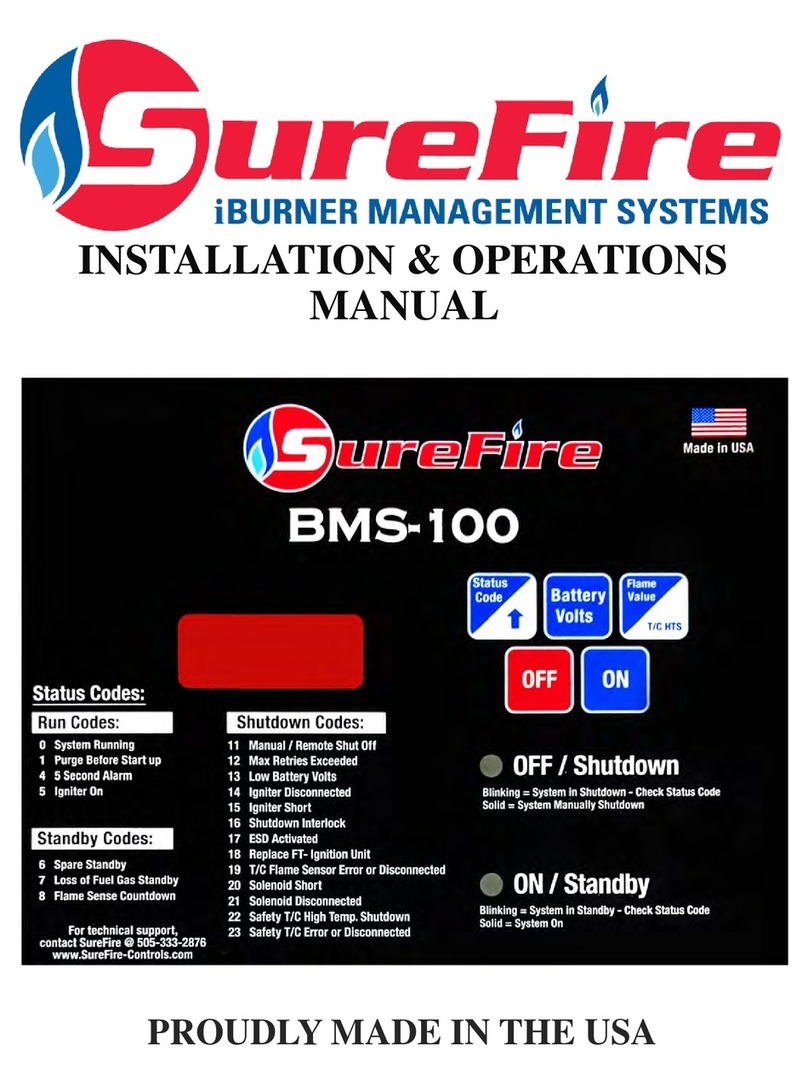
Surefire
Surefire iBURNER BMS-100 Installation & operation manual
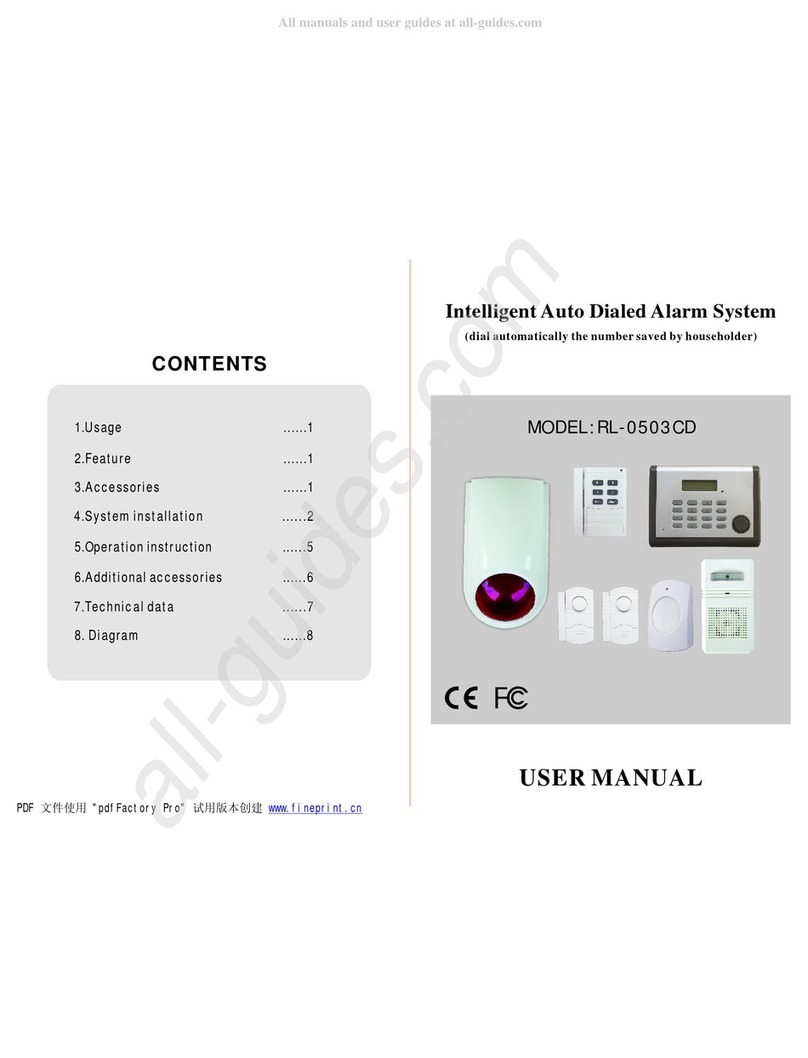
JinCheng
JinCheng RL-0503CD user manual

Risco
Risco Agility 3 Quick installation guide
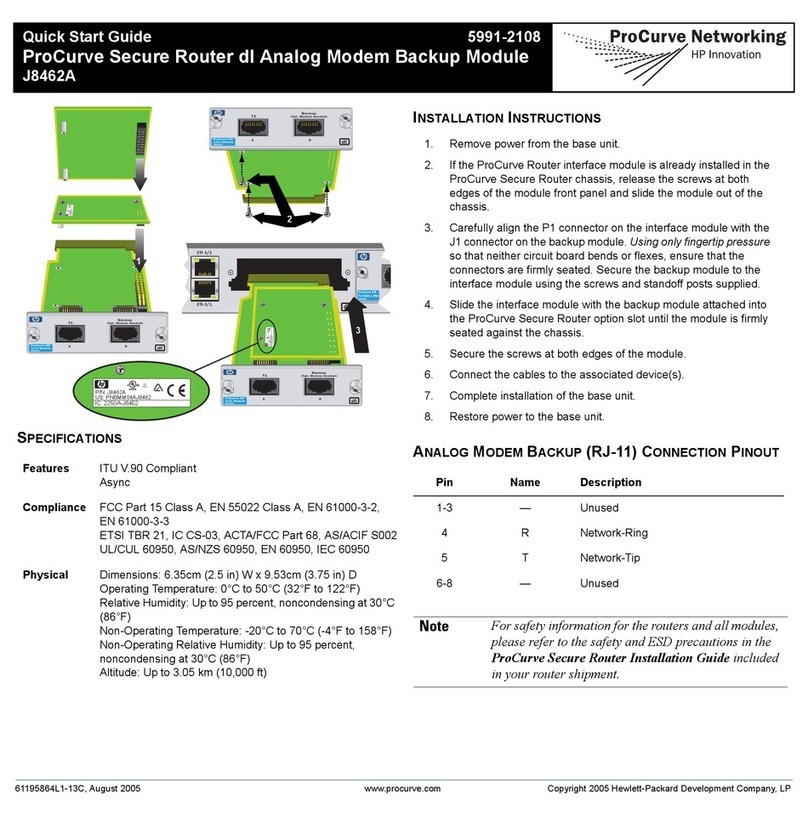
ProCurve
ProCurve J8462A quick start guide
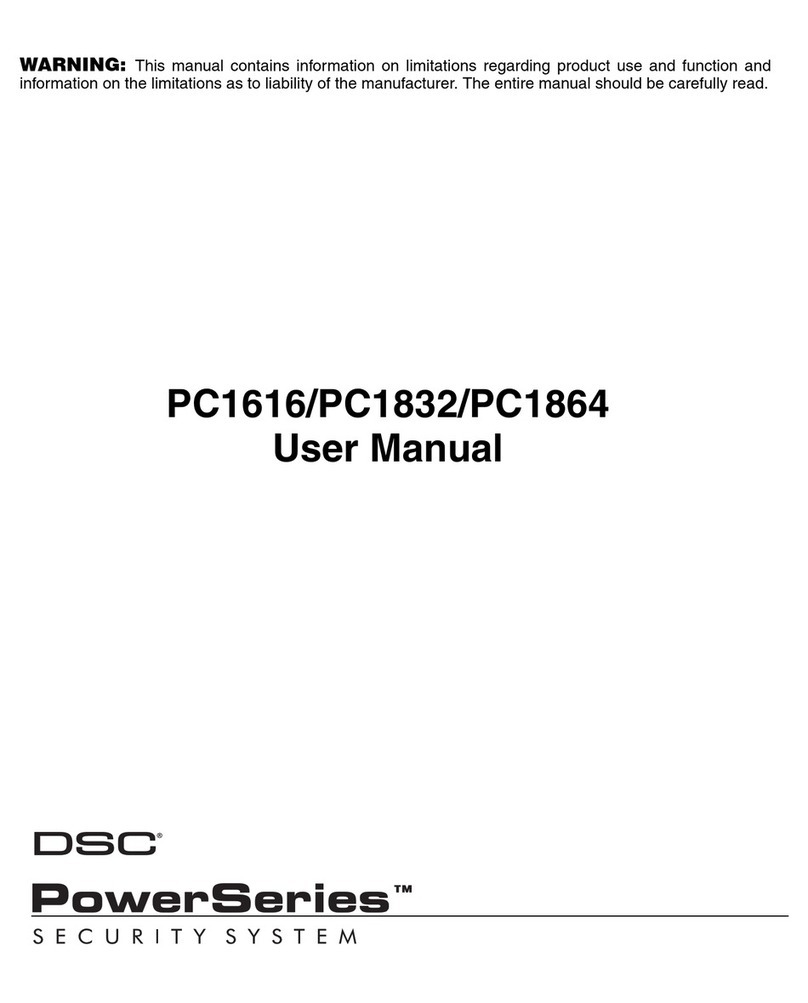
Digital Security Controls
Digital Security Controls PC1616 user manual
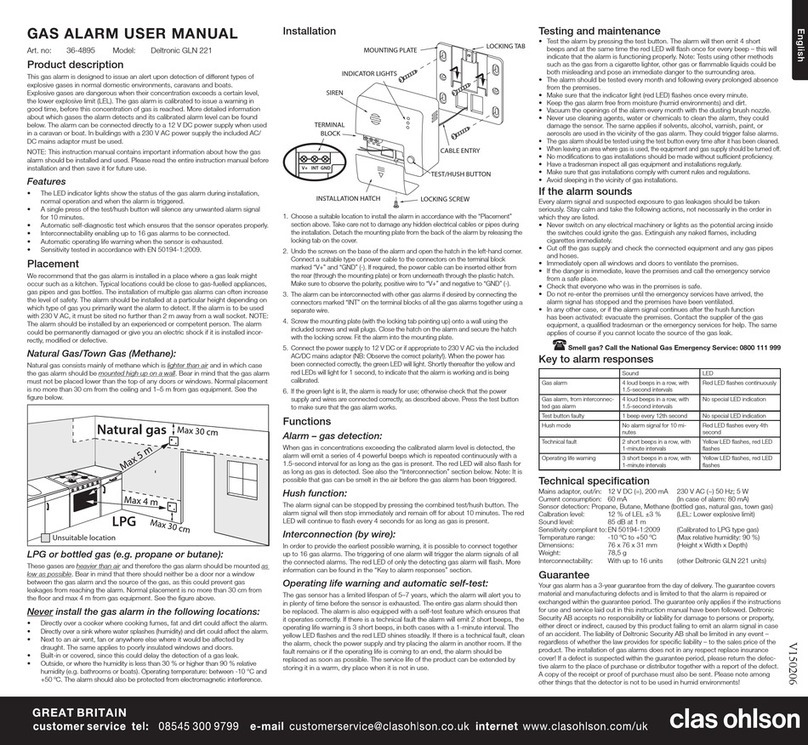
Clas Ohlson
Clas Ohlson Deltronic GLN 221 user manual
